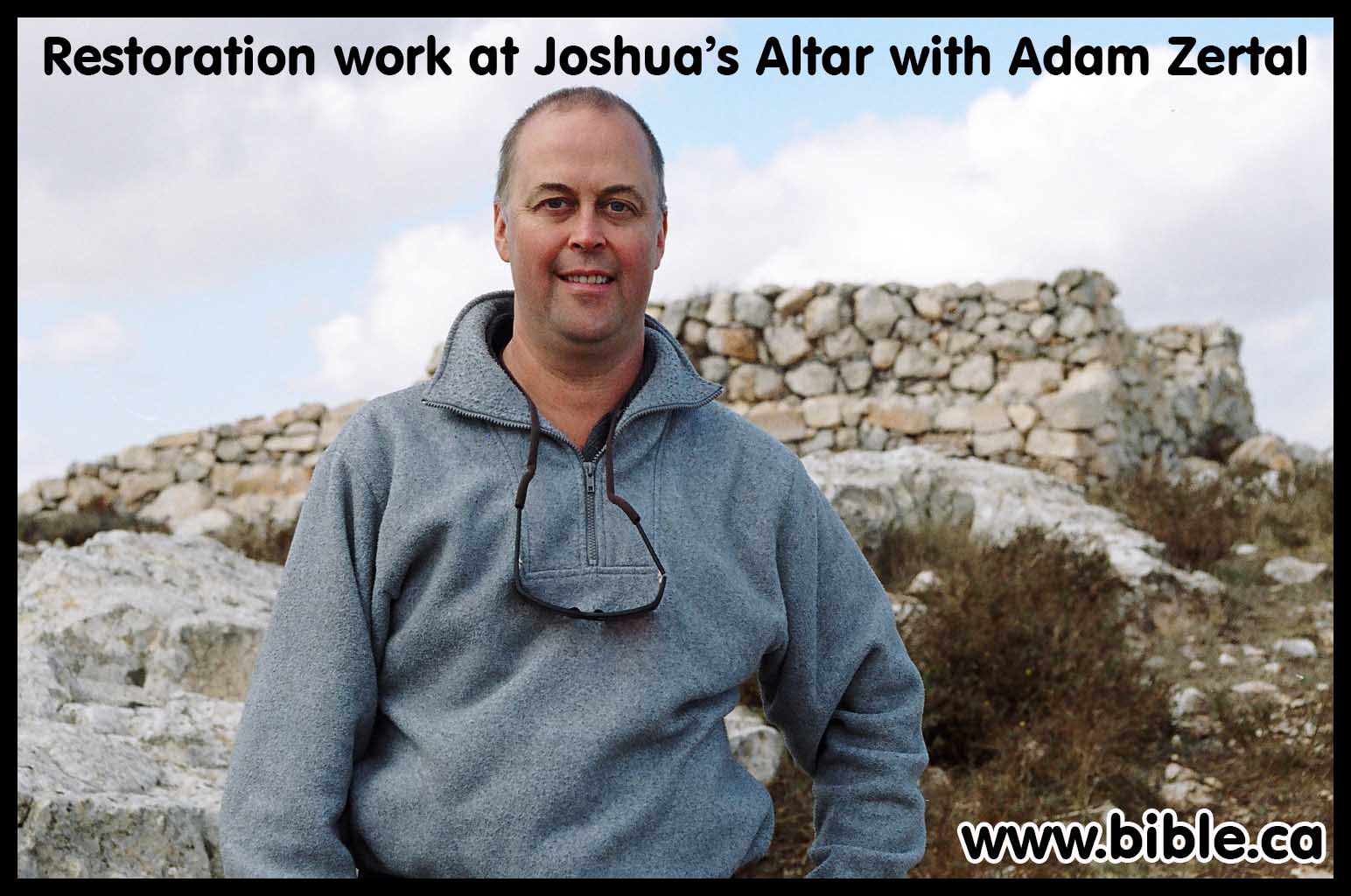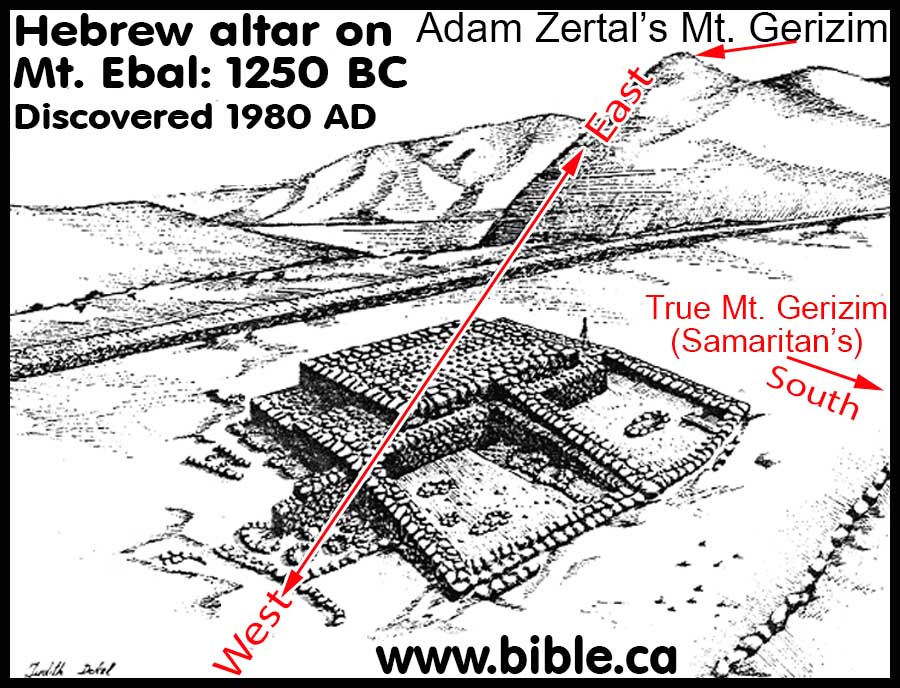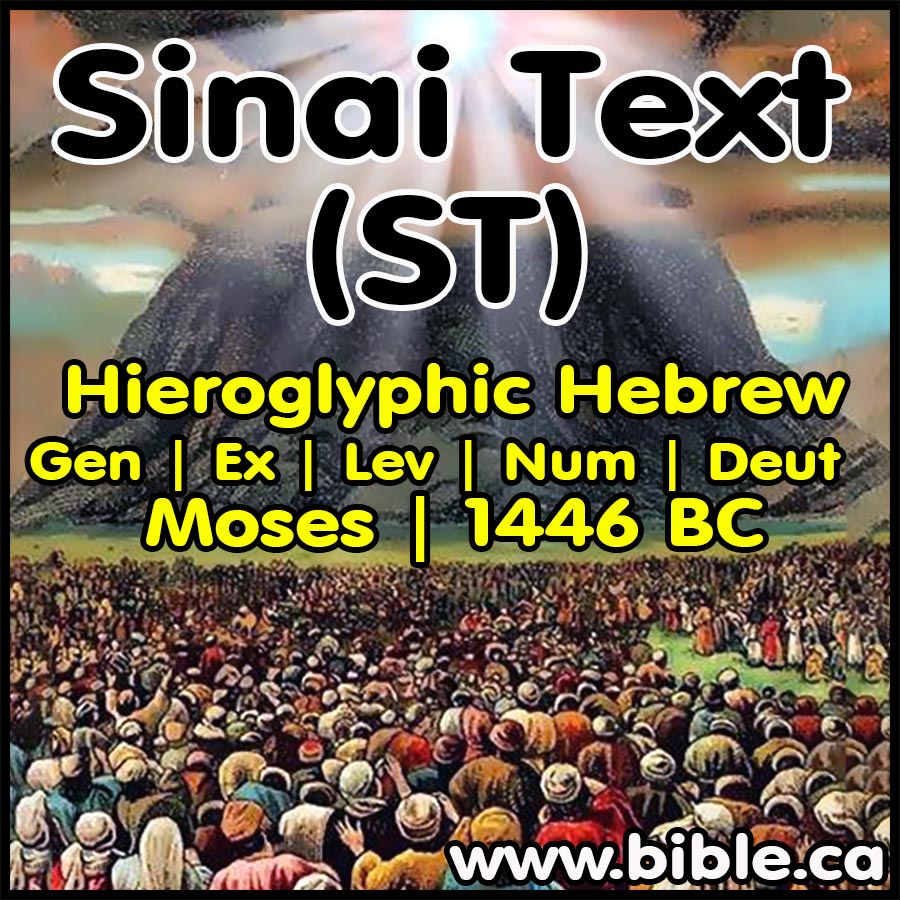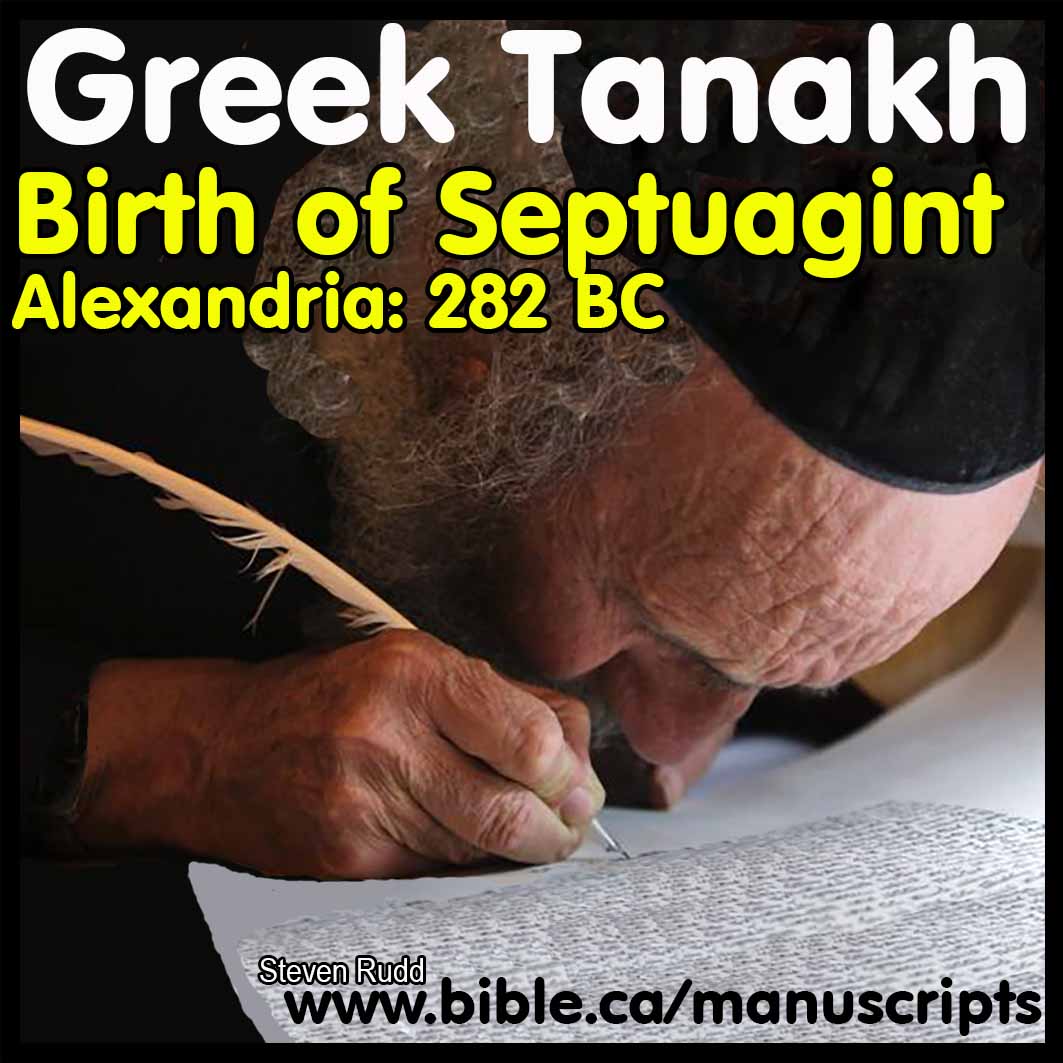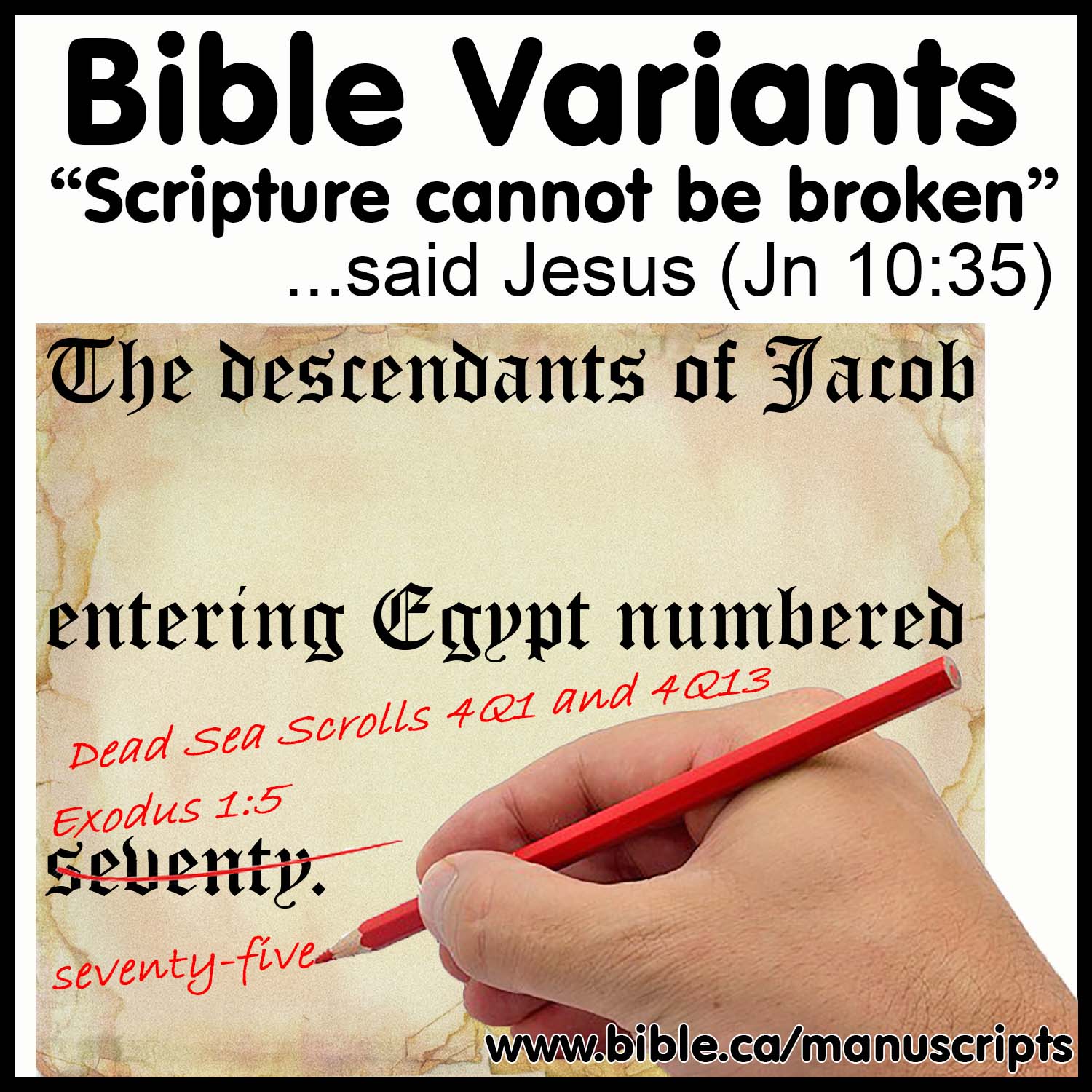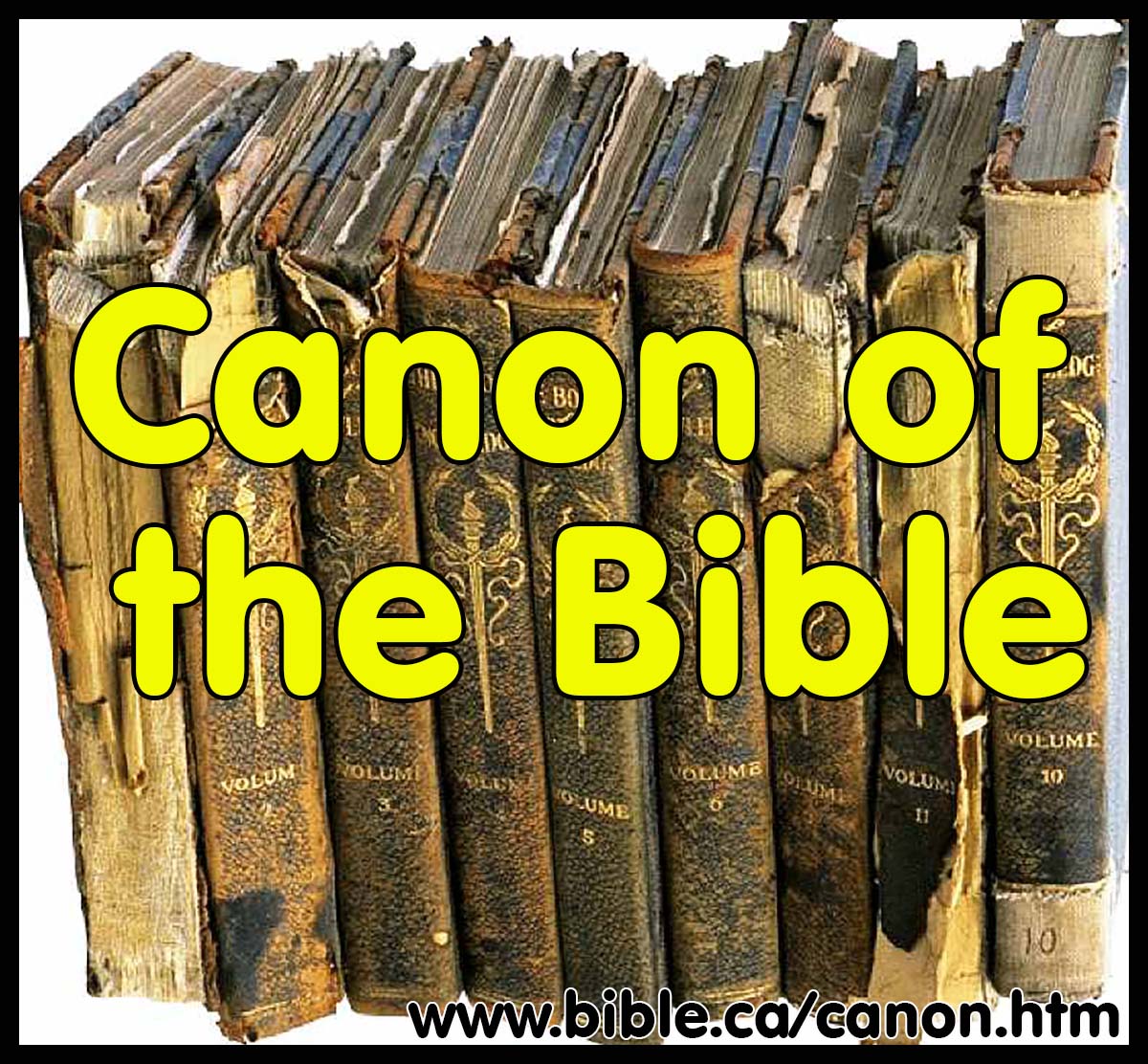|
|
Samaritan Pentateuch Joshua’s Altar on Mt. Gerizim? Deut 27:4 Ezra’s Anti-Samaritan Variants in the Masoretic Text "Scripture cannot be broken" (Jesus, John 10:35) "My word will accomplish what I desire and succeed in the purpose for which I sent it." (Isa 55:11) Steve Rudd November 2017 |
The Samaritans built their Samaritan Temple on Mt. Gerizim to venerate Joshua’s Altar, or so they say!
Samaritan Pentateuch Textual Variants: Joshua’s Altar was on Mt. Gerizim? Deut 27:4
Ezra’s Deliberate Anti-Samaritan Variants in the Hebrew Masoretic Text (MT)
Bible textual variants analysed
See also full outline on the Excavation of “Joshua’s Altar” on Mt. Ebal by Adam Zertal
See also:
1. Ezra’s Anti-Samaritan Variants in the Quattuordecim (XIV)”
2. Ezra’s Variant: Change of tense from past “has chosen” to future “will chose”
3. Ezra’s Variant: Lev 26:31 change of singular “sanctuary” to plural “sanctuaries”
4. Ezra’s Variant: Deut 11:30 Deleted words “opposite Shechem”
Introduction:
While inherently speculative, the Samaritans may have built their Samaritan Temple on Mt. Gerizim to venerate Joshua’s Altar! In other words, the location of the Samaritan temple depended upon the location of Joshua’s Altar. It is also impossible that Joshua’s altar would be built on the “mountain of curses”. The Samaritan argument is as follows: “Stop and think that Israel’s first altar after crossing the Jordan was to build on the mountain of curses-impossible! It had to be built on the mountain of blessings.” However, it makes good sense that the altar was built to atone for the curses on Mt. Ebal. Altars are not built to atone for blessings. The Samaritan Pentateuch instructed Joshua to build his altar on Mt. Gerizim in Deut 27:4. Everyone assumed the Samaritans changed the text from Mt. Ebal to Mt. Gerizim until the recent discovery of a 2100-year-old Hebrew “Dead Sea Scroll F.154” might validate the Samaritan Pentateuch against the Hebrew Masoretic Text. The problem is that DSS F.154 is most likely a forgery and a fraud.
However, we do need to explore the historical smoke and confusion surrounding the locations of Mt. Gerizim and Mt. Ebal. The LXX (Septuagint) and the Madaba map mark two sets of the mountains near Shechem and Jericho. This is bizarre. We know from the book of Judges that Mt. Gerizim was beside Shechem, so why the confusion in the LXX and Madaba map. Even today many Jews, including Adam Zertal say the Samaritan temple was not built on the original Mt. Gerizim. Zertal marks Mt. Gerizim to the east, not to the south were the traditional location of the Samaritan temple marks Mt. Gerizim. Today, we know Zertal was wrong. The Samaritans build their temple on the right Mt. Gerizim.
The author has identified the round altar under the rectangular “Joshua’s Altar” identified by Adam Zertal on Mt. Ebal. The Hebrew rectangular altar structure on Mt. Ebal, that was found buried, dates to 1250 BC which is 150 years too late to be the actual altar Joshua built in 1406 BC. But another possible problem according to the Samaritans, is that Joshua actually built his altar on Mt. Gerizim following the exact instructions of Moses in Deut 27:4, NOT Mt. Ebal. Adam Zertal is on record as saying that the Samaritans chose the wrong location for the true Mt. Gerizim and the original Mt. Gerizim was a third unoccupied peak to the east of Mt. Ebal and north-east of the ancient Samaritan temple.
|
See full outline on the Excavation of “Joshua’s Altar” on Mt. Ebal |
||
The idea that the Samaritans chose the wrong location for Mt. Gerizim is as absurd. The Samaritans chose Mt. Gerizim for their temple because they wanted it to be associated with the mountain of blessings not Mt. Ebal the mountain of curses. So they changed the text of the Torah to have Joshua’s altar built on Mt. Gerizim. The Madaba map marks the correct location of the twin mountains at Shechem and another near Jericho. The Samaritan Pentateuch is in paleo-Hebrew and is a copy of the book of the Law Josiah found in 623 BC. This explains why the Samaritan Pentateuch is variant with both the Masoretic and Septuagint texts on which mountain Joshua was to build his altar on. Yes, Jesus told the Samaritan woman at the well that Jerusalem was God’s holy mountain, not Gerizim and that salvation was from the Jews, but they most certainly knew their Samaritan temple was on top of the location of Joshua’s original altar iof 1406 BC. For all the bad stuff the Samaritans represented as half-breed Jews, their ancient paleo-Hebrew Torah may preserve the original reading for Joshua’s altar on Mt. Gerizim and Ezra the Jew may have changed the text. The Samaritans may have built their Samaritan Temple on Mt. Gerizim to venerate Joshua’s Altar and it is impossible that they got the wrong location for Mt. Gerizim.
Critical evaluation of Deut 27:4b-6 DSS F.154 as a forgery and a fake:
1. DSS F.154 has never been “peer-reviewed published”. In the vacuum of negative publications that conclude F.154 is a forgery, a “congress” that gathers those who believe the DSS is genuine needs to occur fast. At the present, the balance of published materials tip the balance into concluding DSS F.154 is a forgery. However, there is some support among professionals that F.154 is genuine but they need to come together and publish arguments that support the DSS and refute arguments of those who claim it is a forgery (i.e. Ĺrstein Justnes).
2. “There is nothing to suggest that the fragment is genuine; on the contrary, there is much to suggest that it is a modern forgery.” (Forfalskninger av dřdehavsruller, Ĺrstein Justnes, Teologisk Tidsskrift, Vol 6, No. 1, p77, 2017 AD)
3. “In the last fifteen years [starting after AD 2002], more than 70 new Dead Sea scrolls fragments have surfaced on the antiquities market. The fragments come with epic stories of origin but are of uncertain provenance. Over 90% of these are probably forgeries. This article is particularly concerned with one of the fragments, DSS F.154 (Deut 27:4–6, also called the “Har Garizim-fragment”), and will demonstrate how a forgery is introduced, accepted, and eventually becomes part of the dataset. (Forfalskninger av dřdehavsruller, Ĺrstein Justnes, Teologisk Tidsskrift, Vol 6, No. 1, p70, 2017 AD)
4. “Although the fragment is intact in the sense that it consists of only one part, four pieces of tape are attached to the back up against each of the corners of the fragment. The pieces are completely randomly placed and do not seem to have any clear function. The tape does not appear to hold loose pieces together. The explanation is probably this: The fragment has simply been "decorated" with Scotch tape in an attempt to create continuity between the fragment and the first research team who were known for using such tape to hold/patch manuscripts with several fragments together. This is about imitation and ultimately about authentication. The handwriting on the fragment is inconsistent and hesitant, and it seems strikingly enough to consist of letters from different time periods. This is also pointed out by Charlesworth: "The scribal hand represents archaic forms that can be dated perhaps to 175 BCE and later forms that date from around 50 and even conceivably to 30 BCE (but we cannot ascertain when such forms first appeared)." Despite Charlesworth's harmonizing presentation, it is difficult to get away from the fact that handwriting from different time periods is an indication of forgery. Furthermore, the letters seem to be marked by the fragment's shape and damage patterns. The letter “zayin” in line 2 and “alef” in line 3, for example, are adapted to holes in the fragment, and the last “lamed” is pressed down since the fragment "slopes" towards the left. All this tells us that the fragment was probably inscribed in modern times. The content and similarities with modern text editions Charlesworth follows the Exodus fragment all the way, and he actually holds all the roles: He is the one who launches, authenticates, publishes - and probably also facilitates. The most important substantive contribution that this fragment makes - the reading "Mount Garisim" - is placed towards the middle of the fragment. We also see this in other forgeries, most recently the gospel of the infamous wife of Jesus. Interestingly, the words "have Garizim" are written together, as they are stated in the critical apparatus in Biblia Hebraica Stuttgartiensia (BHS). Also in verse 5, DSS F.154 reads “them” in accordance with the critical apparatus in BHS instead of the main text. On “them”, such an import of reading from the critical apparatus in modern editions is at all characteristic of many of the new fragments.” (Forfalskninger av dřdehavsruller, Ĺrstein Justnes, Teologisk Tidsskrift, Vol 6, No. 1, p75, 2017 AD)
In conclusion, the Samaritans built their temple on Mt. Gerizim to associate their temple with the mountain of blessings. The Samaritans changed the text of their Torah they got from Josiah so that the Altar of Joshua was built on Mt. Gerizim, not Mt. Ebal as the autograph text read at the time of Joshua.
Discussion:
I. Historical context of Ezra in 458 BC:
1.
623 BC: Abisha Torah Scroll: 1065 AD: The Samaritan priest at Bethel acquires a Paleo-Hebrew copy of the
Torah from Jerusalem.
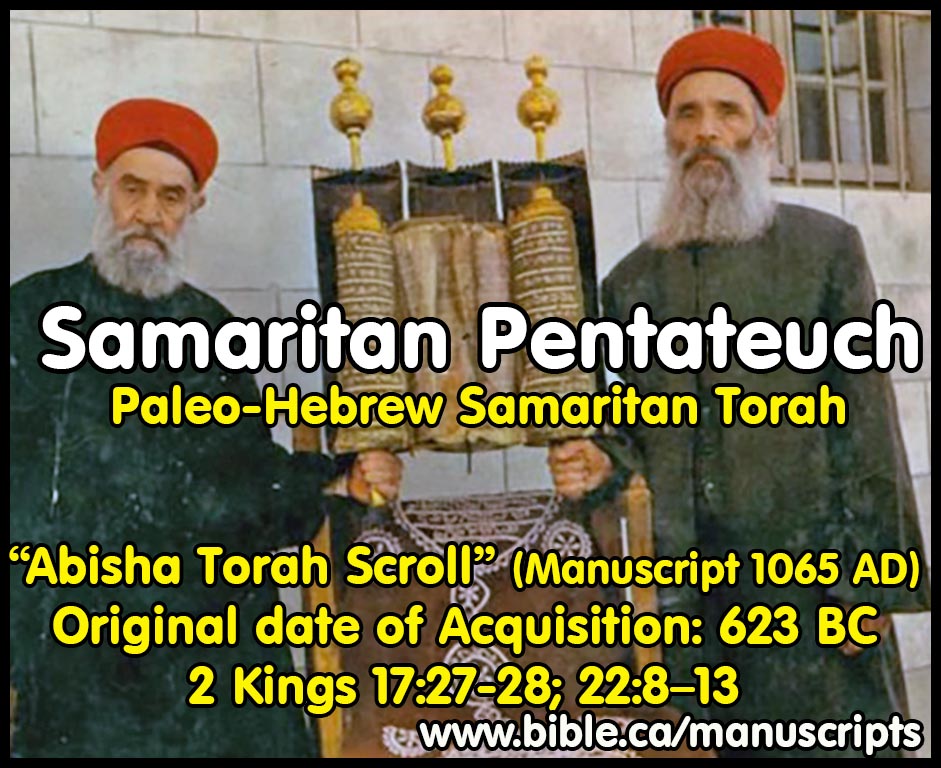
a. The Samaritans got a copy of the paleo Hebrew Torah from Josiah after he found the book of the law in 623 BC. He was a good king and a reformer king. Surely, he would give a copy very willingly to anyone wanting to follow God and give up idolatry. At the time of Josiah there was really no difference in God’s eyes between the Judea Jews and the Samaritan/Assyrians because both worshipped YHWH and idols.
b. “There is no doubt that this distinct version of the Israelite Samaritan Torah originated during the most ancient period of the people of Israel. The historian Josephus Flavius in his book the Antiquity of the Jews (book 13, lines 74-79) tells about a debate during the second century B.C.E. in the city of Alexandria, Egypt, between Jewish and Samaritan sages regarding the preeminence of each respective Pentateuch, and especially about the original holiness of their most sacred place, the Temple Mount in Jerusalem for the Jews and Mount Gerizim in the region of Samaria for the Israelite Samaritans. This debate happened before Ptolemy Philomater VI (181-145 B.c.E.) the king of Egypt. It is not surprising that Samaritan sources describe the outcome of the debate as a victory for the Samaritans, whereas Jewish sources and Josephus marked it as a victory for the Jews. Samaritan Chronicles date the first debate to the time of Darius II, king of Persia, in the sixth century B.C.E. The Jewish sage, Rabbi Eleazer, continued the uninterrupted debate about the authenticity of different texts, complaining that the Samaritans had forged the Torah. Joint claims of forging the Torah are found in both Jewish and Samaritan community sources chronicling their history in ancient times. In actuality, the two versions represent two different groups of people. The old polemic between Jews and Samaritans eventually subsided for hundreds of years, due to the separation between the two communities.” (The Israelite Samaritan version of the Torah: First English translation compared with the Masoretic version, Benyamim Tsedaka, Sharon Sullivan, The First English Translation of the Israelite Samaritan Torah, Benyamim Tsedaka, p xxi, 2013 AD)
c. “WHO HAS CHANGED? Scholars conclude that the Israelite Samaritan pronunciation of Hebrew has not changed since the Second Temple period, and likewise the cantillation of their vocalizations remains unique. The Samaritans have maintained the Passover sacrifice without change since the time of the exodus, beginning their calendar in the Spring as specified in the Pentateuch (Exod. 12:2). They have made their pilgrimages for the three main festivals to Mount Gerizim without change since ancient times. They enter their synagogue barefoot, as instructed in the Torah (Exod. 3:5), covering their heads while entering the holy place, wearing special clothes on their Sabbaths — as since ancient times. They write in a form of ancient Hebrew script, as found in some of the Dead Sea Scrolls. They keep the laws of impurity and have done so since ancient times, insisting on total separation of the husband from his wife when she is impure. These facts lead to the next question in regard to the two versions of the Torah: If indeed the Samaritans have never changed most of the original customs throughout the ages, did they preserve the ancient text better than other Israelite groups who have altered most of their customs?” (The Israelite Samaritan version of the Torah: First English translation compared with the Masoretic version, Benyamim Tsedaka, Sharon Sullivan, The First English Translation of the Israelite Samaritan Torah, Benyamim Tsedaka, p xxx, 2013 AD)
d. JOSIAH FINDS LOST BOOK OF THE LAW: "Then Hilkiah the high priest said to Shaphan the scribe, “I have found the book of the law in the house of the Lord.” And Hilkiah gave the book to Shaphan who read it. Shaphan the scribe came to the king and brought back word to the king and said, “Your servants have emptied out the money that was found in the house, and have delivered it into the hand of the workmen who have the oversight of the house of the Lord.” Moreover, Shaphan the scribe told the king saying, “Hilkiah the priest has given me a book.” And Shaphan read it in the presence of the king. When the king heard the words of the book of the law, he tore his clothes. Then the king commanded Hilkiah the priest, Ahikam the son of Shaphan, Achbor the son of Micaiah, Shaphan the scribe, and Asaiah the king’s servant saying, “Go, inquire of the Lord for me and the people and all Judah concerning the words of this book that has been found, for great is the wrath of the Lord that burns against us, because our fathers have not listened to the words of this book, to do according to all that is written concerning us.”" (2 Kings 22:8–13)
e. “Then the king of Assyria commanded, saying, “Take there one of the priests whom you carried away into exile and let him go and live there; and let him teach them the custom of the god of the land.” So one of the priests whom they had carried away into exile from Samaria came and lived at Bethel, and taught them how they should fear the LORD." (2 Kings 17:27-28)
f. “The five books of Moses are the only part of the Jewish Canon accepted by the Samaritans. It cannot well be supposed that they adopted these books as canonical after [grammar note: the author is saying that the Samaritans adopted the Torah BEFORE the breach/rift with the Judeans] the decisive breach between Samaritan and Jewish communities, or indeed after the embitterment of relations between them. Dates suggested for the breach have varied between the fifth and first centuries B.C.; but the majority opinion has favored the latter part of the fourth century. Fresh light has been shed in recent years on the history of the Samaritan community by excavations at Shechem and by the discovery of fourth-century Aramaic papyri at Wadi Daliyeh, and on the history of the Samarian form of the text of the Pentateuch by the Qumran material.” (The Cambridge History of the Bible, Shemaryahu Talmon, The Old Testament Text, p 123, 1970 AD)
g. “The manuscript most venerated by the Samaritans, from which all other copies are reported to originate, is the Abisha Scroll, housed in the synagogue at Nablus. This scroll presents itself as written by Abisha, son of Pinhas, son of Eleazar, son of Aaron, in the thirteenth year after the Israelites entered the land of Canaan. Its reputed antiquity, traced back to the very earliest days of the Israelite experience, gives the scroll a place of honor within the Samaritan community. Unfortunately, modern scholarship has been unable to substantiate this claim of the scroll’s ancientness. Although the scroll gives the appearance of “great antiquity” and the scribal notation dates the scroll to 1065 c.e., a significant portion of modern research dates the scroll to no earlier than the middle of the twelfth century c.e. Even if it cannot be attributed to the great-grandson of Aaron, the scroll’s great age and its special place within the Samaritan community make the scroll worthy of high regard. The Abisha Scroll is only one manuscript among many that have become available to the scholarly community, and the last decades of the twentieth century witnessed an increase in scholarly interest directed toward the various Samaritan manuscripts. In collections around the world, there are just under one hundred manuscripts of the sp that date from before the eighteenth century. With few exceptions (notably the Abisha Scroll and modern copies sold to tourists), most existing pre-twentieth-century manuscripts are in codex form. The earliest of the manuscripts date from the perhaps the eleventh century c.e. (the Abisha Scroll), and a sizable quantity come from the fourteenth and fifteenth centuries c.e. Typically, these are written in the Paleo-Hebrew script with the text appearing in two columns per page.” (Tradition Kept: The Literature of the Samaritans, R. Anderson, Giles, p11, 2005 AD)
h. “The Samaritan Hebrew of antiquity was similar to Judean Hebrew. It was supplanted as a spoken language by Aramaic after the turn of the eras, although it remained in use for liturgical compositions. After the conquest of Palestine by the Muslims in the early seventh century C.E., spoken and written Aramaic gradually gave way to Arabic. Probably in the eleventh century, the latter became the only spoken language of the Samaritans and the language in which they composed their historical, exegetical, grammatical, halakhic, medical, astronomical, and other works. In the thirteenth/fourteenth century, colophons and deeds of sale in manuscripts as well as liturgical compositions began to be written in a special Hebrew, called variously “Samaritan,” “Late Samaritan Hebrew,” “Neo-Samaritan Hebrew,” “Samaritan Neo-Hebrew,” or “Hybrid Samaritan Hebrew.” It is heavily influenced by Aramaic and Arabic. Its creation was due to the fact that the Hebrew of the Pentateuch was no longer sufficient to express the thoughts of the medieval poets. Used eventually for writing religious poetry (piyyutim), prayers, chronicles, deeds of sale, marriage contracts, letters to European scholars, and other writings, from the fourteenth century to the present, it was never a language spoken in everyday life. In the late nineteenth and early twentieth century the Samaritans used an archaizing form of Hebrew—sometimes called “ ‘Judaized’ Samaritan Hebrew”—to write chronicles for the consumption by European scholars who were interested in the Samaritans. Since these scholars were familiar with the Hebrew Bible, the Samaritans adapted their style to this readership by incorporating ancient Hebrew diction. Among the works written in this artificial language are the Samaritan Hebrew Book of Joshua, the Chronicle Adler (also called New Chronicle), the so-called Chronicle II, and the Hebrew translations of Arabic works made at the request of Moses Gaster. The use of this language ceased after the first three decades of the twentieth century, when the Samaritans began to interact with the Jewish community in Palestine. In their synagogue service the Samaritans use only Hebrew and Aramaic. (The Samaritans: A Profile, R. Pummer, p 220, 2016 AD)
2. 561-533 BC: The Great Samaritan conversion to Monotheism.
a. We know that sometime after 561 BC the Samaritans embraced full monotheism and gave up idol worship forever, as seen in the first century and today.
b. The Mt. Gerizim as their temple would have been in full operation prior to the rebuilding of the Jewish temple at Jerusalem even though it was likely a mix of paganism and monotheism.
c. The Samaritans are using a paleo-Hebrew copy of the Torah that dates to between when Josiah finds the book of the law in 623 BC and the Babylonian captivity in 605 BC.
d. There is no other way to get a copy of the paleo-Hebrew Torah into their hands. If after 500 BC it would have been in the new updated script of Ezra called, “Aramaic (square) Hebrew”.
3. 536 BC: Decree of Cyrus to end captivity and allow Jews to return to Judea
4. 533 BC: Jews arrive in Jerusalem, rebuild the alter of burnt offerings on its old foundation and lay the foundation of the Temple in a smaller footprint size: Ezra 3:3-10
a. "So they set up the altar on its foundation, for they were terrified because of the peoples of the lands [near Jerusalem]; and they offered burnt offerings on it to the Lord, burnt offerings morning and evening." (Ezra 3:3)
b. "Now when the builders had laid the foundation of the temple of the Lord, the priests stood in their apparel with trumpets, and the Levites, the sons of Asaph, with cymbals, to praise the Lord according to the directions of King David of Israel." (Ezra 3:10)
c. Notice the Jews were afraid of the peoples of the lands around Jerusalem, not perhaps the Samaritans specifically.
5. 533 BC: EZRA CREATES HIS OWN ENEMY: SAMARITAN VS. JEW WAR IS STARTED: Sincere Samaritans made a genuine offer to rebuilt the Jerusalem Temple but are rejected
a. "Now when the enemies of Judah and Benjamin heard that the people of the exile were building a temple to the Lord God of Israel, they approached Zerubbabel and the heads of fathers’ households, and said to them, “Let us build with you, for we, like you, seek your God; and we have been sacrificing to Him (at Bethel and Mt. Gerizim) since the days of Esarhaddon king of Assyria, who brought us up here.”" (Ezra 4:1–2)
b. What is key here is to realize that the Samaritans had no “tricks up their sleeves” or ill intent. They were excited and really wanted to help the Jews build the temple in Jerusalem.
c. We know from Ezra 3:3 that Ezra was afraid of the locals in the Jerusalem area so when a sincere group of Samaritans offered to help, Ezra refused.
d. Notice in Ezra 4:1 that these Samaritans are called enemies, and yes after they
e. The mass Samaritan conversion from a mix of paganism and YHWH worship to pure monotheism must have taken place before the Jews arrived in Jerusalem and Ezra likely didn’t know this.
f. Notice in Ezra 2:61–70 that after they arrived in Jerusalem and before they started rebuilding that, Ezra had removed any Levite priests who had intermarried. The Samaritans were a population of 100% mixed marriages and had a long history of idol worship up until 561 BC.
g. The Samaritan’s initial request to help the Jews was IN GOOD FAITH, and when refused, we have a case of THE JILTED LOVER that is first hurt, then gets angry. Then the Samaritans start a theological war with Ezra by pointing out (wrongly) that Joshua’s Altar was built on Mt. Gerizim and that Jerusalem is not Holy to God. To irk Ezra even more, the Samaritans are using the very copy of the Paleo-Hebrew Torah given to the Samaritans by Josiah between 623-609 BC.
h. Ezra created his own enemy in the Samaritans: Once Ezra refused to let the sincere Samaritan offer to help built the temple, they were first hurt then angry and became bitter enemies down to the time of Christ.
i. It is interesting that the Muslim Hatred of the Jews today can be traced back to the time when Muhammed asked the Jews to convert to Islam. When they refused (rightly so) Muhammed redirected his followers prayers from Jerusalem to Mecca and its been “death to Jews” ever since.
j. In the end, Ezra made the right choice because the Samaritans were not full blooded Jews.
6. 533 BC: SAMARITAN TEMPLE ON MT. GERIZIM BUILT:
a. The original paleo-Hebrew Torah stated that Joshua’s Altar was built on Mt. Gerizim.
i. As witnessed by Dead Sea Scroll, 4QDeuteronomyf Frag. 32-35, the text of the Paleo Hebrew bible at Deuteronomy 27:4 in 465 BC indeed says that Joshua built an altar on Mt. Gerizim. This is how the Paleo-Hebrew Samaritan Pentateuch, Exodus 12:14a-f reads today.
ii. Vetus Latina: Old Latin translation of the Pentateuch also reads “Garzin” in codex 100
iii. Papyrus Giessen from the fifth/sixth century C.E. also read “Garzin” which was based on an Old Greek reading and possibly an Old Hebrew reading from Jewish not Samaritan sources.
iv. The Samaritan temple was built were Joshua’s altar was and it is ridiculous to suggest they got the mountain wrong.
b. The Samaritans had been sacrificing at Bethel and Mt. Gerizim for some time.
c. After being rejected by Ezra, the Samaritans build (or upgrade) the first Samaritan temple on Mt. Gerizim.
d. Archeological conclusions date the Samaritan temple to the Persia empire:
i. “In the excavator’s opinion, the temple, which must have stood in the temenos or sacred precinct, was built in the fifth century B.C.E. and rebuilt in the Hellenistic period. In the course of the excavations, remains of numerous buildings came to light that belonged to a large city surrounding the temple. It began to grow in the Hellenistic period, and eventually, i.e., in the second century B.C.E., reached a size of 800 × 500 m, becoming the main city of the Samaritans. It is now certain that the first phase of the sacred precinct dates to the Persian period, and not to the time of Alexander the Great, as Josephus asserted, and many later authors repeated. In the Persian period the temple precinct was about 96 × 98 m in size and was built of local field stones. Adjacent to a large chamber gate (with six or eight chambers) in the northern wall, a sizable (11 × 12 m) building was uncovered; therein excavators found a large number of burned bones, together with a great amount of ashes. Even though later constructions in the Hellenistic and Byzantine periods destroyed much of the Persian period structure, it seems that with its three chamber gates in the north, east, and south, it resembled the temple built by the returnees from Babylon who probably modeled their temple on the plan preserved in the Book of Ezekiel. The gates in the Mt. Gerizim Persian-period precinct must have been similar to those in the temple described in Ezekiel 40:10–16 and 46:1–3. It should be pointed out, though, that Magen assumes that the Persian period temple “was most probably copied at Mt. Gerizim by the Jewish priests who followed the grandson of Eliashib, who was married to the daughter of Sanballat the Horonite (Neh. 13:28).” On the basis of the thousands of pottery vessels and burned animal bones (sheep, goats, cattle, and doves), the coins from the Persian period, and Carbon-14 testing, this phase of the temple has been dated to the mid-fifth century B.C.E. Thus, when Josephus claims that the temple was founded in the time of Alexander the Great, he is mistaken. After the Persian-period temple had existed for 250 years, a new precinct (and temple) was built in the Hellenistic period, i.e., in the early second century B.C.E.” (The Samaritans: A Profile, R. Pummer, p 80, 2016 AD)
7. 531-520 BC: Enemies, including the Samaritans, stop work on temple from time of Cyrus to 2nd year of Darius I: Ezra 4:4-7,24
a. Cyrus: 539 - 530 BC
b. Cambyses II: 530 - 522 BC
c. Darius I: 522-486 BC: Ezra 4:4-5
8. 520 BC: The prophets Haggai and Zechariah order the Jews to resume building the temple: Ezra 5:1
a. Ezra 5:3-17: The enemies ask the Jews who gave them permission to rebuild and the Jews reply, “Cyrus”. The enemies think the Jews are lying and ask Darius to search for decree of Cyrus.
b. Ezra 6:1-12: Darius finds the decrees of Cyrus, warns the enemies not to interfere but to provide whatever needed and orders building of the temple resumes again.
9. 516 BC: Ezra 6:13-18: Jerusalem temple is completed
a. The Tanakh in Ezra’s possession at this time is in Paleo-Hebrew.
b. Ezra 6:18: The Jews follow oral instructions of Ezra regulate temple worship, perhaps acquired from the Samaritans.
10. 486-465 BC: Ezra 4:6: Enemies hinder Jews rebuilding city of Jerusalem during the reign of Xerxes (Ahasuerus): 486-465 BC
11. 483-473 BC: Story of Esther who saves the Jews from a holocaust at the hands of Haman.
12. 465 BC: Ezra 4:7-16: The Samaritans (in part, see Ezra 4:10) hinder Jews rebuilding city of Jerusalem during the reign of Artaxerxes I: 465-423 BC.
a. The enemies, the Samaritans, Rehum the commander and Shimshai the scribe, write a letter to Artaxerxes to stop rebuilding the walls of Jerusalem.
b. The king replies to the Samaritans (“to the rest of their colleagues who live in Samaria” Ezra 4:17) and Artaxerxes I orders the Jews to stop rebuilding Jerusalem.
13. 465 BC: The Samaritan Jewish Torah wars become intense:
a. The Samaritans totally oppose the Jewish temple and rebuilding the city.
b. The Samaritans have been misusing the Torah to assert that their temple on God’s Holy Mountain Gerizim is where God’s blessings are.
c. The Samaritans argue that Joshua built an altar on Mt. Gerizim in 1399 BC and now that Jerusalem and Solomon’s temple are destroyed, this is proof God is blessing the Samaritans.
d. Joshua’s altar was built on Mt. Gerizim:
i. As witnessed by Dead Sea Scroll, 4QDeuteronomyf Frag. 32-35, the text of the Paleo Hebrew bible at Deuteronomy 27:4 in 465 BC indeed says that Joshua built an altar on Mt. Gerizim. This is how the Paleo-Hebrew Samaritan Pentateuch, Exodus 12:14a-f reads today.
ii. Vetus Latina: Old Latin translation of the Pentateuch also reads “Garzin” in codex 100
iii. Papyrus Giessen from the fifth/sixth century C.E. also read “Garzin” which was based on an Old Greek reading and possibly an Old Hebrew reading from Jewish not Samaritan sources.
iv. The Samaritan temple was built to venerate Joshua’s altar was and it is ridiculous to suggest they got the mountain wrong.
e. The Jews are seriously irked, most of whom Ezra, who knows the Samaritans are wrong about Mt. Gerizim being God’s holy mountain instead of Jerusalem.
14. 458-445 BC: EZRA TRANSLATES PALEO-HEBREW BIBLE INTO “ARAMAIC HEBREW” MANUSCRIPTS AMONG THE JEWS:
a. See full outline on Ezra translating the scripture into Aramaic Hebrew
b. Ezra gathers all the paleo-Hebrew Bible manuscripts, (including perhaps, a paleo-Hebrew copy of the Torah from the Samaritans) and translates them into the new Aramaic Hebrew script, which will be used down to 70 AD and seen commonly in the Dead Sea Scrolls. There are many ancient literary sources that say Ezra restored all the Bible manuscripts that were lost during the destruction of Solomon’s temple in 587 BC.
i. 2 Maccabees 2:13–32, 124 BC
ii. 2 Esdras 14:21-26, 90 AD
iii. Irenaeus, Against Heresies 3.21.2, 180 AD
iv. Clement of Alexandria, Misc. 1.22.149, 185 AD
v. Samaritan Chronicles 7, Adler, 16th Excerpt, The deceit of Zerubbabel, Nehemiah, and Ezra
c. While Ezra was bilingual, the Jewish population could not speak, read or write Hebrew. Instead they spoke Aramaic from the time of the captivity down to the first century in Judea.
d. Ezra was the sole top expert in sole possession of the paleo-Hebrew manuscripts, which only he could read.
e. Ezra translated the Paleo-Hebrew bible manuscripts into Aramaic Hebrew (Square) which still, only he could read, not the general population.
f. Note: Aramaic “square” Hebrew is the Hebrew language spelled using the Aramaic alphabet. It is the Hebrew language, no Aramaic. Ezra simply substituted the more common Aramaic alphabet for the more archaic paleo-Hebrew alphabet.
15. 458-445 BC: EZRA creates minor variant changes in the text of the Torah to counter Samaritan arguments favoring Mt. Gerizim
a. Until recently, Scholars have wrongly viewed these variants as Samaritan corruptions, when in fact it was Ezra who corrupted the text of the Torah.
b. This explains why the current Masoretic text and the Septuagint both agree against the Samaritan Pentateuch: The changes of Ezra predated the LXX by ~170 years.
c. Ezra changes the location of Joshua’s altar from Mt. Gerizim to Mt. Ebal in Deuteronomy 27:4.
d. Ezra changes the tense in 21 places for the location of the temple from “has chosen” [in 1446 BC] to future “will chose”: Deut 12:5, 11, 14, 18, 21, 26; 14:23, 24, 25; 15:20; 16:2, 6, 7, 11, 15, 16; 17:8, 10; 18:6; 26:2; 31:11. The Samaritans argued that the past tense “the place in which the Lord your God has chosen for His name to dwell” can only mean Gerizim and ruled out Jerusalem.
e.
Ezra created the fiction that the Samaritans had chosen
the wrong location for Mt. Gerizim beside Shechem and began to say the correct
location was near Jericho. This bizarre lie is seen in the fact that the Madaba
map in 325 AD marks both locations of Mt. Gerizim. Even more strange is the
fact Eusebius sided with the Jews against the Samaritans in his Onomasticon.
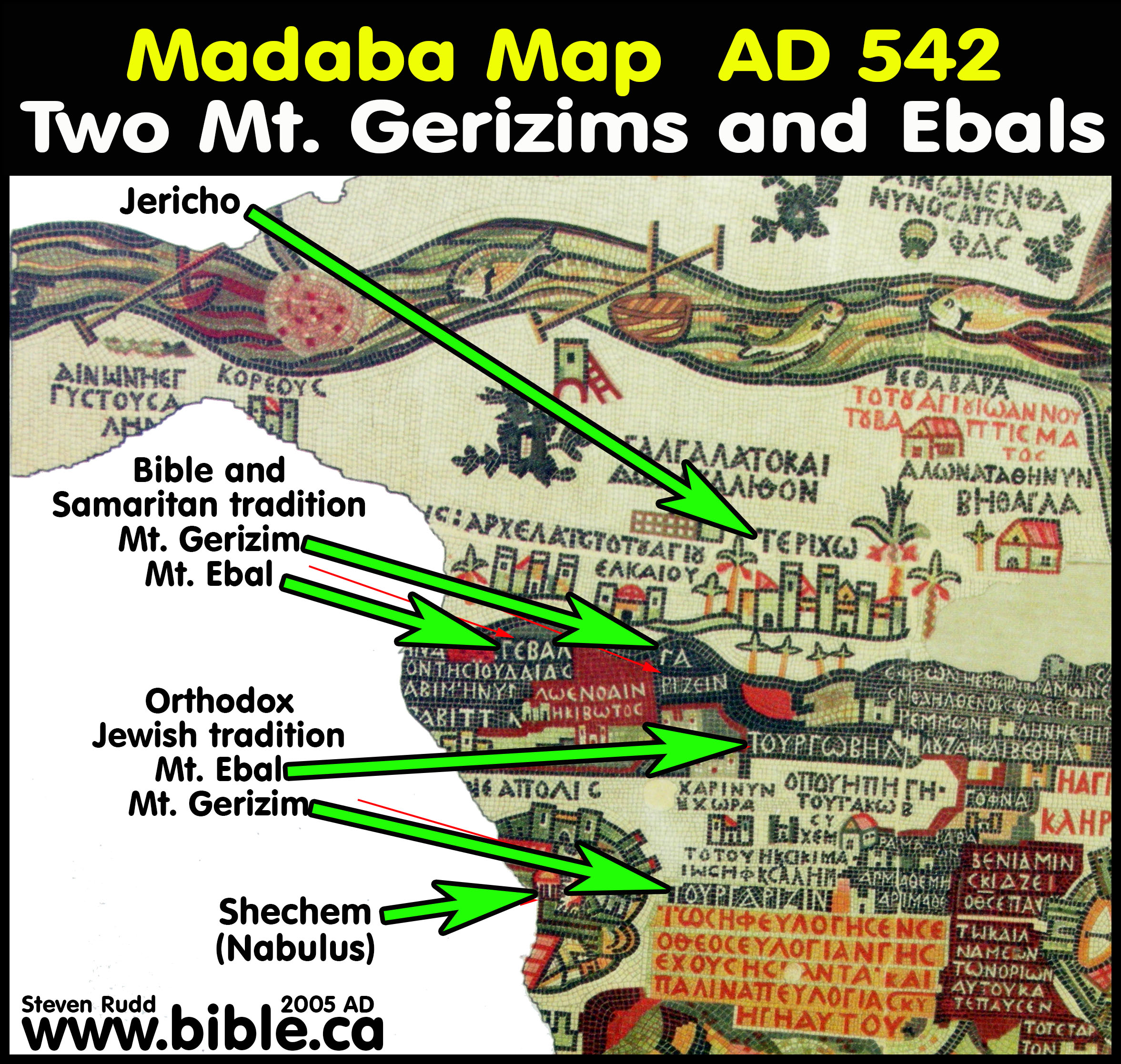
f.
Even today Jews believe the Samaritans have chosen the
wrong location for Mt. Gerizim. The
author, while excavating “Joshua’s Altar”, took this photograph as Adam
Zertal standing on Mt. Ebal, said the mountain behind him to the east was the
true location of Mt. Gerizim. He has also published this view.
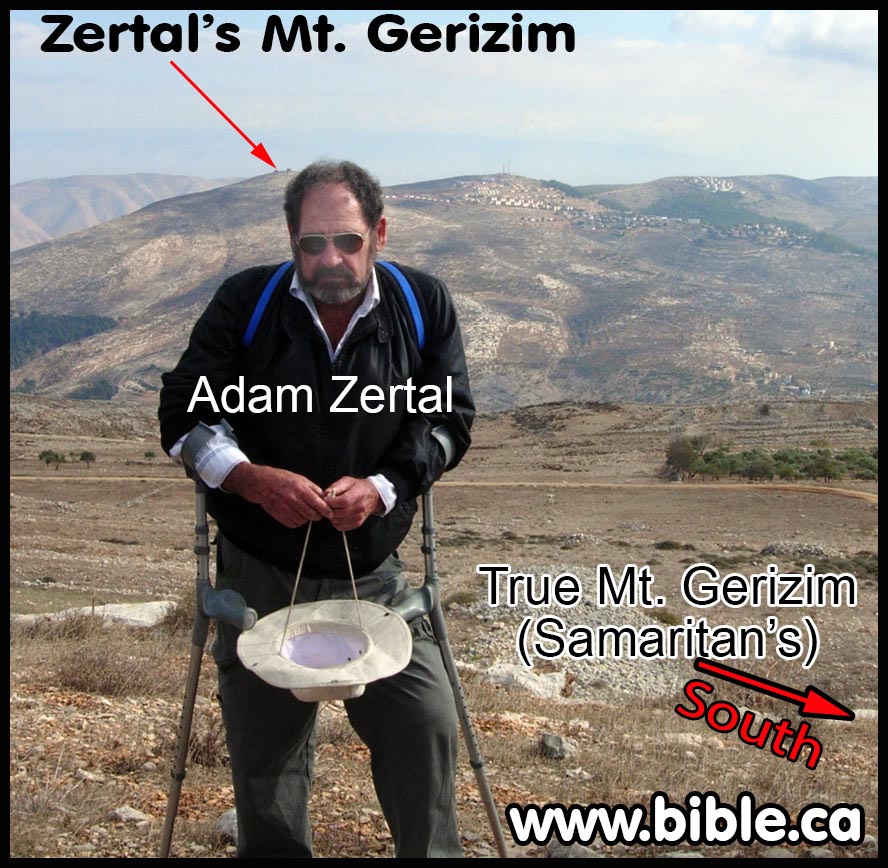
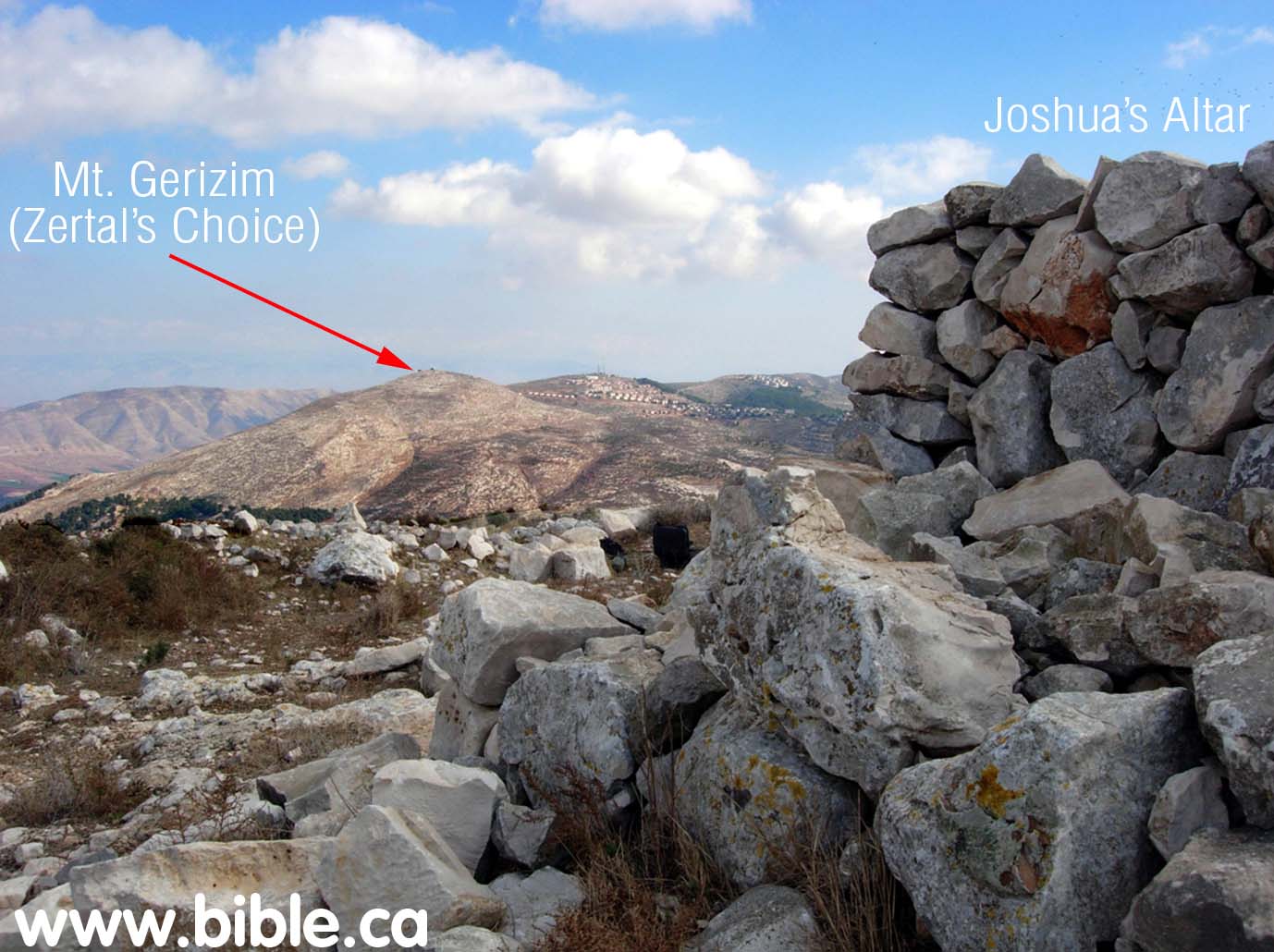
g. All these changes predated the translation of the Septuagint in 282 BC which along with the Masoretic text, contain these minor and insignificant “anti-Samaritan” corruptions to the present day.
16. 458 BC: Begin 70 weeks of Daniel 9:14:
a. Ezra 7:8: Decree to rebuild Jerusalem in 7th year of Artaxerxes I.
b. 490 years to 3 April 33 AD.
c. Daniel’s 70 weeks is exactly 490 years from 458 BC – 33 AD and ends at the cross.
d.
Premillennialists who “stop the clock” at week 69 for a pause that has
lasted for 2000 years, get the starting time wrong but should just be slapped
out of their silliness, or stated in a more academic way, they should “reconsider
their extemporizations”, especially since pre-tribulation
rapture doctrine was invented by John Darby in 1830 AD.

II. Examining the evidence of the Dead Sea Scroll that reads “Mt. Gerizim”: Deuteronomy 27:4B-6
1. “The second hypothesis is markedly different. The original reading of Deuteronomy, “on Mount Gerizim,” is preserved in this fragment. Thus, it should not be labeled “a variant;” the MT and related texts preserve the “variant” and it looks redactional and later. Here are the reasons for this suggestion. 1) Most importantly, the text of Deuteronomy mentions two mountains: the Mountain of the Curse or Ebal and the Mountain of Blessing or Gerizim: “You shall pronounce the blessing at Mount Gerizim and the curse at Mount Ebal” (Deut 11:29 TANAKH). One would expect, therefore, that the author or compiler of Deuteronomy wrote that Moses conveyed the instruction to build God’s altar on Mount Gerizim and not Mount Ebal as in the MT and LXX text of Deut 27:418 (which influenced the Vulgate, Syriac, and Coptic traditions).19 Moreover, just a few lines later we hear the following: “After you have crossed the Jordan … stand on Mount Gerizim when the blessing for the people is spoken” (Deut 27:11 TANAKH). One would have expected the author or compiler of Deuteronomy to have quoted Moses as exhorting the building of an altar (27:5) on Mount Gerizim (as in this fragment) and not on Mount Ebal (as in the MT and related texts). 2) Sacred texts often refer to specific locations as hallowed; scribes who copied these passages sometimes lived and worked among Jews who challenged (or even rejected) the honor bestowed on the place mentioned. These scribes might have assumed that the correct reading may not be in a manuscript available for copying. They certainly knew about numerous versions of a biblical book and might have imagined the reading they wanted was in one of them. Regarding the reading in our fragment of Deuteronomy, after John Hyrcanus destroyed the Samaritan places of worship on Mount Gerizim, it is conceivable that a Jew, especially one in Judea, in the middle of the first century BCE – or less than one hundred years after Hyrcanus’ destruction of the buildings on Mount Gerizim about 112 BCE20 – would have thought that Moses had intended to have God’s altar built on Mount Ebal and not on the Samaritan’s Mount Gerizim which lay in ruins and belonged to the Samaritans. Copying scribes in Judea, and especially in Jerusalem, would have copied Deuteronomy in the first century BCE with a hatred of Samaritans. Perhaps the copyist even imagined that the Samaritans were not “Jews” but belonged to the “many nations” that were to be obliterated from the Holy Land. He may have thought that God ordered their “altars” to be destroyed (Deut 7:1-5).21 This speculation is supported by the vast evidence of numerous text types of biblical texts that circulated in the late first century BCE; each text type was probably deemed sacred by the circle of those who heard the text. Our scribe may not have seen “Mount Ebal” in his exemplar or copies but he may well have imagined that this meaning must have been implied by the author of Deuteronomy. For at least fifty years, scholars have stated that before 70 CE copying scribes did not consider the Hebrew text of Scripture to be unalterable, because the text’s consonantal form was still fluid. (See Y. Magen, H. Misgav, and L. Tsfania, Mount Gerizim Excavations (Jerusalem: Israel Antiquities Authority, 2004) vol. 1, p. 13.) Copying scribes altered the text in good faith in the attempt to restore the correct reading and to remove possibilities of misunderstanding. They sought to serve the circle of Jews for whom the copy was intended. I suggest that our fragment preserves the original reading and indicates that the MT and related textual traditions reflect alterations. To me, this second hypothesis is persuasive, indeed confirmed, because of the reading of the Old Latin: garzin (Latin Cod. 100).23 It is unlikely that the Old Latin is dependent on the Samaritan Pentateuch. It is conceivable that a Latin scribe knew the Tendenzen of Deuteronomy and changed the text. It is more likely, however, that the Old Latin reading derives from a lost Greek manuscript or even a Semitic manuscript (perhaps like the one now announced).24 In any case, the reading of Old Latin Codex 100 seems to clinch the argument that our manuscript preserves the original reading and is not a portion of the Samaritan Pentateuch. Most likely the Samaritans followed an old reading that originated in the North and is Samarian (not Samaritan). All of us need to reconsider what we mean by “Samaritan,” “Proto-Samaritan,” and similar terms; the “new” fragment challenges us to improve our perceptions of tensions between Judeans and Samaritans and to refine our nomenclature.” (What is a Variant? Announcing a Dead Sea Scrolls Fragment of Deuteronomy, James H. Charlesworth, 2010 AD)
2. “In the early Israelite text, as presented in the Jewish Masoretic version, why was Mt. Gerizim changed to Mt. Ebal? To answer this question, we must look into the highly complicated political and theological disputes between Jews and Samaritans in the late Persian and early Hellenistic periods (late fourth to early third centuries B.C.). It was then that the final schism occurred between what were two branches of early Second Temple Judaism. It was then that the foundation of the Samaritan Temple was laid on Mt. Gerizim, emphasizing the final separation of the Samaritans from Jerusalemite Judaism. The rivalry between Gerizim and Jerusalem resulted in “correcting” the Biblical passages in Deuteronomy 27 and Joshua 8, so that they referred to Ebal instead of Gerizim, which had become (and remains) the center of Samaritan worship. This textual change most probably occurred between 350 and 300 B.C.” (Joshua’s Altar—An Iron Age I Watchtower, Aharon Kempinski, BAR 12.01, Feb 1986 AD)
3. “This new discovery from Qumran, and the fact that the same reading for Deut. 27:4-6 occurs also in Vetus Latina as well as in the Samariticon, the Greek translation of the Samaritan Pentateuch, leads the translator to suggest that "in Mount Gerizim" should no longer be considered a "Samaritan correction" but should be regarded as an original Israelite text, dating many hundreds of years before the rise of the Jewish-Samaritan polemics of the Second Temple period. Regarding the close relationship between the Samaritan Pentateuch and some of the Dead Sea Scrolls, Martin Abegg explains that the 4QpaleoExod(m) reading of Exod. 6:25 is "the most extensive witness to the book of Exodus. Besides being written in Paleo Hebrew, it is important because it introduces passages from Numbers and Deuteronomy. Before the discovery of the Dead Sea Scrolls, we had known this practice only from the later manuscripts of the Samaritan Pentateuch. 4QpaleoExod(m) thus forms an early witness to the form of the Bible that was later adopted by the Samaritan community.” (The Israelite Samaritan version of the Torah: First English translation compared with the Masoretic version, Benyamim Tsedaka, Sharon Sullivan, The First English Translation of the Israelite Samaritan Torah, Benyamim Tsedaka, p xxv, 2013 AD)
4. “The second option is to assume that this fragment preserves the original reading. Thus, some scribe changed "Ebal" to "Gerizim." Not knowing the newly recovered fragment shown earlier but well aware of the Old Greek and Old Latin readings as well as the MT, Magnar Kartveit states: "The conclusion is that the `Gerizim' in Deut. 27:4 is older than the reading `Ebal' of the MT." In exploring these options, two categories should be distinguished: fragments of the Samaritan Pentateuch and fragments of manuscripts that preserve Samaritan readings (and may be pre-Samaritan). One should distinguish between a copy of the Samaritan Pentateuch and old readings (known in the Samaritan Pentateuch and reflected often in the LXX and elsewhere) that appear in pre-7o Hebrew scrolls. Hence, "Proto-Samaritan Texts" should be defined as manuscripts preserving textual traditions that are not caused by Samaritan editing and appear not only in the Samaritan Pentateuch but also in some Qumran biblical manuscripts, namely 4QpaleoExodm;16 4QNumb;17 41158; and 4Q364.18 These manuscripts are not portions of the Samaritan Pentateuch, because they do not contain the Samaritan redactional features of the Pentateuch. The study of the transmission of the Pentateuch indicates that Samaritans and other early Jews shared an early stage of traditions and Scripture. We should keep in focus the possibility that a manuscript with a reading found in the Samaritan Pentateuch may not be the result of editing by Samaritans; it may represent an early reading. Thus, the MT and other related text types may represent redactions by others, notably Jews in Judea, especially after the burning of the Samaritan "altar" by John Hyrcanus in the late second century B.C.E. … I suggest that our fragment preserves the original reading and indicates that the MT and related textual traditions reflect alterations.” (The Israelite Samaritan version of the Torah: First English translation compared with the Masoretic version, Benyamim Tsedaka, Sharon Sullivan, What Is the Samaritan Pentateuch?, James H. Charlesworth, p xix, 2013 AD)
5. “Recently, in conversation with Michael Corinaldi that took place in October 2008, following his massive comparative research of the text of the Torah from Qumran along with the new discovery of Deut. 27:4-6, Shemaryahu Talmon changed his view of the SP to accept the necessity of giving the same respect to the SP and MT. The discovery of the Dead Sea Scrolls renewed the debate among scholars, due to the fact that in Qumran Cave 4 were discovered ancient fragments identical in textual structure to the Samaritan Pentateuch, especially many fragments of the book of Exodus. As well, many fragments were identical with the version of the Greek Septuagint, the "Translation of the Seventy.".” (The Israelite Samaritan version of the Torah: First English translation compared with the Masoretic version, Benyamim Tsedaka, Sharon Sullivan, The First English Translation of the Israelite Samaritan Torah, Benyamim Tsedaka, p xxi, 2013 AD)
6. “Emanuel Tov, a brilliant scholar of the Dead Sea Scrolls, ascertained that three different texts of the Pentateuch were discovered at Qumran: a Proto-Jewish, a Proto-Samaritan, and an independent text. He suggested that part of the fragments were delivered to Qumran by Jews who preferred isolated life in the desert over life in the big cities, and part were written by them in the desert. It should be pointed out that all of the Dead Sea Scrolls were copied or written by Jews. Undoubtedly, this demonstrates that the general structure of the text, the so-called Samaritan version, was not a special version but was in use by Jews as well. Previously some scholars claimed that Samaritan sages harmonized the text in the books of Exodus, Numbers, and Deuteronomy, yet this proved to be meaningless since the same texts were found in Qumran. Some scholars claimed that the Samaritan sages made additions to the original text, or edited it to conform it to their particular faith. However, the same claim could be applied to the Jewish version as edited and crystallized so as to adjust it to the Jewish faith, as in the case of "will choose" replacing "has chosen" or in the case of Deut. 27:4-6, "Mount Ebal" replacing "Mount Gerizim." In general, it can be said that any claim against either of the two groups as having changed the original text should be postponed until discovery of the original text.” (The Israelite Samaritan version of the Torah: First English translation compared with the Masoretic version, Benyamim Tsedaka, Sharon Sullivan, The First English Translation of the Israelite Samaritan Torah, Benyamim Tsedaka, p xxiv, 2013 AD)
7. “A not-yet fully published fragment of Deuteronomy [27:4B-6] has challenged what we specialists mean by "the Samaritan Pentateuch," "the Proto-Samaritan Text," and readings in the Samaritan Pentateuch. As we seek to comprehend the importance of this witness to Deuteronomy, Emanuel Tov rightly warns that the so-called "proto-Samaritan" manuscripts found in the Qumran caves are neither Samaritan nor sectarian. This Dead Sea Scroll forces us to ask questions: How do we know that the differences between the Samaritan Pentateuch and the MT version of the Pentateuch are caused by alterations made by Samaritans? How do we know that the readings in the Samaritan Pentateuch are to be classified as "variants"? Why is the Samaritan Pentateuch assumed to be redactional, even inferior to MT? The only previously published Qumran fragment that witnesses to Deut. 27:1-10 is 4QDeutf frgs. 32-35; but that text has a lacuna where the mountain (Ebal or Gerizim) would have been mentioned.” (The Israelite Samaritan version of the Torah: First English translation compared with the Masoretic version, Benyamim Tsedaka, Sharon Sullivan, What Is the Samaritan Pentateuch?, James H. Charlesworth, p xviii, 2013 AD)
8. “The reading “Mount Gerizim” (written as one word in the Samaritan Pentateuch: בהרגרזים) in Deuteronomy 27:4 was likewise thought in the past to be a Samaritan sectarian correction from the Masoretic Text’s original “Mount Ebal.” However, after it was realized that the Old Latin translation of the Pentateuch also reads “Garzin” in codex 100 as does the Papyrus Giessen from the fifth/sixth century C.E., it was surmised that this reading is based on an Old Greek reading and possibly an Old Hebrew reading that was a general Jewish, not a peculiarly Samaritan, reading. A recently emerged small fragment (3.8 × 2.9 cm), said to come from Cave 4 in Qumran, made this a likely assumption. It preserved the text of Deuteronomy 27:4–6 with the reading בהרגרזים “on Mt. Gerizim” in one word. The genuineness of the fragment does not seem to be in doubt, and everything points to an identification of the text as a general Jewish text. Some scholars have therefore concluded that “Gerizim” in Deuteronomy 27:4 was original and was later changed by Jewish writers out of animosity against the Samaritan place of worship on this mountain.” (The Samaritans: A Profile, R. Pummer, p 204, 2016 AD)
9. “At the outset of examining this fragment we should note the spelling of "Mount Gerizim" as one word and in a form with only seven consonants (hrgrzim). This practice is clearly a Samaritan practice, but it does not define a fragment as a portion of the Samaritan Pentateuch. As Talmon points out, the form also appears in scrolls and texts that are not Samaritan: "Agarisin" in the Latin of 2 Macc. 5:23 and 6:2, "Argarizin" in Josephus's War 1.6, and "Mons Agraris" in Pliny's Natural History (V.14.68).13 Thus, the presence of this form — one word with seven consonants — does not prove that the scroll is a Samaritan text.” (The Israelite Samaritan version of the Torah: First English translation compared with the Masoretic version, Benyamim Tsedaka, Sharon Sullivan, What Is the Samaritan Pentateuch?, James H. Charlesworth, p viii, 2013 AD)
10. “The so-called pre-Samaritan texts are not Samaritan documents, as they lack the specifically Samaritan readings. In our view, the pre-Samaritan texts formed a relatively sizable group that may well have been a popular textual tradition of the Torah used in ancient Israel in the last pre-Christian centuries in addition to texts of the MT family. It is reflected in 4QpaleoExodm, 4QExod-Levf, 4QNumb and secondarily also 4QDeutn and possibly 4CLLevd (it is also found in a recently found fragment of Deut. 27:4-6 that is still under investigation). It is also reflected in 4QRPa (4Q158) and 4QRPb (4Q364), which were previously considered to be rewritten Bible texts, and it is used by 4QTest (4Q175) in the quotation from Exodus and by the author of the Jubilees manuscripts. The best-preserved pre-Samaritan text is 4QpaleoExodm, of which large sections of forty-four columns from Exodus 6-37 have been preserved. Significant sections of several additional texts have also been found.” (The Israelite Samaritan version of the Torah: First English translation compared with the Masoretic version, Benyamim Tsedaka, Sharon Sullivan, Foreword, Emanuel Tov, p x, 2013 AD)
III. The Textual Variant at Deut 27:4:
1. Variant Texts Deut 27:4
a. “So it shall be when you cross the Jordan, you shall set up on Mount Ebal, these stones, as I am commanding you today, and you shall coat them with lime." (Deuteronomy 27:4, MT)
b. "And it shall be when you pass over the Jordan, you shall set up these stones that I am commanding you today in Mount Ebal, and you shall plaster them with plaster." (Deuteronomy 27:4, LXX)
c. "And it shall be when you cross the Yaardaan [Jordan], you shall set up on Aargaareezem [Mt. Gerizim], these stones which I am commanding you today. And you coat them with lime." (Deuteronomy 27:4, Samaritan Pentateuch, SP)
d. “14a And when Shehmaa your Eloowwem will bring you to the land of the Kaanannee which you are going to inherit it. 14b You shall set yourself up great stones and lime them with lime. And you shall write on them all the words of this law. 14C And when on have passed over the Yaardaan you shall set up these stones, which I command today, in Aargaareezem [Mt. Gerizim]. 14d And there you shall build an altar to Shehmaa your Eloowwem, an altar of stones. You shall lift up no iron on them. 14e And you shall build the altar of Shehmaa your Eloowwem of complete stones. 14f And You shall offer burnt offerings thereupon to Shehmaa your Eloowwem. 14g And you shall sacrifice offerings and shall eat there. And you shall rejoice before Shehmaa your Eloowwem. 14h That mountain, in the other side of the Yaardaan, beyond the way toward the sunset, in the land of the Kaanannee who dwell in the prairie, before the Gaalgaal, beside the Aalone moora, before Ashkem." (Samaritan Pentateuch, Exodus 12:14a-f)
2. Related Bible Texts:
a. "When Sanballat the Horonite [Beth-Horon is 10 km NW of Gibeon] and Tobiah the Ammonite official heard about it, it was very displeasing to them that someone had come to seek the welfare of the sons of Israel." (Nehemiah 2:10)
b. "Now prior to this, Eliashib the priest, who was appointed over the chambers of the house of our God, being related to Tobiah, had prepared a large room for him, where formerly they put the grain offerings, the frankincense, the utensils and the tithes of grain, wine and oil prescribed for the Levites, the singers and the gatekeepers, and the contributions for the priests. But during all this time I was not in Jerusalem, for in the thirty-second year of Artaxerxes king of Babylon I had gone to the king. After some time, however, I asked leave from the king, and I came to Jerusalem and learned about the evil that Eliashib had done for Tobiah, by preparing a room for him in the courts of the house of God. It was very displeasing to me, so I threw all of Tobiah’s household goods out of the room. Then I gave an order and they cleansed the rooms; and I returned there the utensils of the house of God with the grain offerings and the frankincense." (Nehemiah 13:4–9)
IV. Archeological Literary Texts:
1.
175-50 BC: Dead Sea Scroll: Newly discovered fragment of Deuteronomy [27:4B-6] that places
Joshua`s altar on Mt. Gerizim is most likely a forgery and fake.
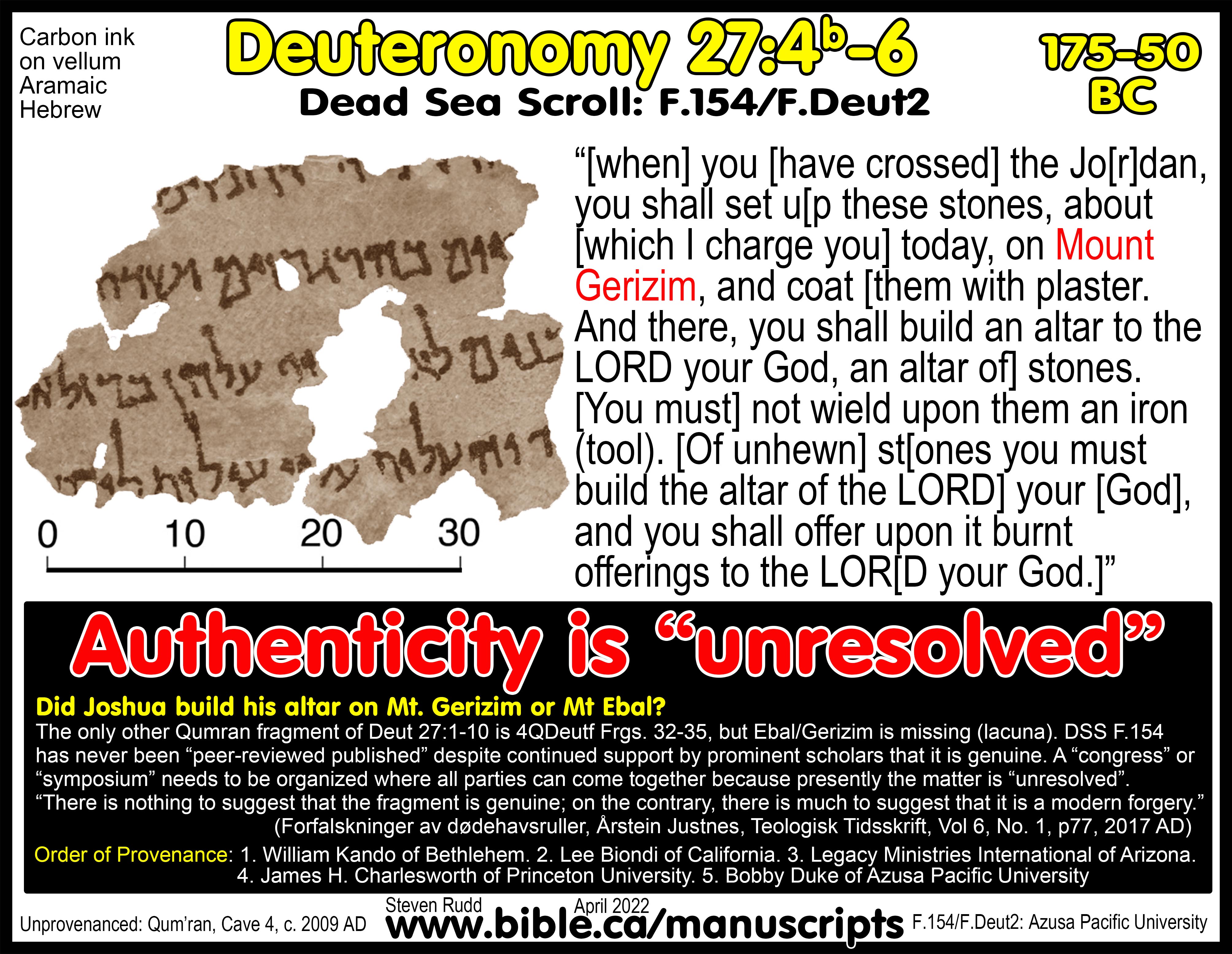
a. This fragment is not Samaritan but a Hebrew document.
b. “(Line 4) [when] you [have crossed] the Jo[r]dan, you shall set u[p these stones, about [which I charge you] today, on Mount Gerizim, and coat [them with plaster. (L5) And there, you shall build an altar to the LORD your God, an altar of] stones. [You must] not wield upon them an iron (tool). (L6) [Of unhewn] st[ones you must build the altar of the LORD] your [God], and you shall offer upon it burnt offerings to the LoR[D your God.]" (Dead Sea Scroll, Deuteronomy 27:4B-6)
c. This new fragment is not the same as 4Q33 Deuteronomy f.
2. 70 AD: Josephus
a. “Now it came to pass that the Alexandrian Jews, and those Samaritans who paid their worship to the temple that was built in the days of Alexander at Mount Gerizzim, did now make a sedition one against another, and disputed about their temples before Ptolemy himself, the Jews saying that, according to the law of Moses, the temple was to be built at Jerusalem; and the Samaritans saying that it was to be built at Gerizzim. (75) They desired therefore the king to sit with his friends and hear the debates about these matters, and punish those with death who were baffled. Now Sabbeus and Theodosius managed the argument for the Samaritans, and Andronicus, the son of Messalamus, for the people of Jerusalem; (76) and they took an oath by God and the king, to make their demonstrations according to the law; and they desired of Ptolemy, that whomsoever he should find that transgressed what they had sworn to, he would put him to death. Accordingly, the king took several of his friends into the council, and sat down, in order to hear what the pleaders said. (77) Now the Jews that were at Alexandria were in great concern for those men, whose lot it was to contend for the temple at Jerusalem: for they took it very ill that any should take away the reputation of that temple, which was so ancient and so celebrated all over the habitable earth. (78) Now when Sabbeus and Theodosius had given leave to Andronicus to speak first, he began to demonstrate out of the law, and out of the successions of the high priests, how they every one in succession from his father had received that dignity, and ruled over the temple; and how all the kings of Asia had honored that temple with their donations, and with the most splendid gifts dedicated thereto: but as for that at Gerizzim, he made no account of it, and regarded it, as if it had never had a being. (79) By this speech, and other arguments, Andronicus persuaded the king to determine that the temple at Jerusalem was built according to the laws of Moses, and to put Sabbeus and Theodosius to death. And these were the events that befell the Jews at Alexandria in the days of Ptolemy [IV] Philometor. [180-145 BC]” (Josephus Antiquities 13.73-79, 180-145 BC)
b. “But when Hyrcanus heard of the death of Antiochus he presently made an expedition against the cities of Syria, hoping to find them destitute of fighting men, and of such as were able to defend them. (255) However, it was not till the sixth month that he took Medaba, and that not without the greatest distress of his army. After this he took Samega, and the neighboring places; and, besides these, Shechem and Gerizzim, and the nation of the Cutheans, (256) who dwelt at the temple which resembled that temple which was at Jerusalem, and which Alexander permitted Sanballat, the general of his army, to build for the sake of Manasseh, who was son-in-law to Jadua the high priest, as we have formerly related; which temple was now deserted two hundred years after it was built.” (Josephus Antiquities 13.254–256)
3. 30 BC: 2 Maccabees
a. "Now after not much time, the king sent an Athenian elder to compel the Judeans to depart from the laws of their fathers and to not live according to the laws of God, but to pollute themselves and even to call the temple in Jerusalem by the name of “Zeus who dwells on Olympus” and the one in Gerizim “Zeus the Guardian of Hospitality,” just as those who inhabit the region happen to do. And the violence of wickedness was cruel and grievous in every respect." (2 Maccabees 6:1–3, 30 BC)
4. 90 BC: Dead Sea Scroll 4Q33 Deuteronomy f. (4QDeuteronomyf, 4QDeutf: Frag. 32-35, Deut 26:18–27:10):
a. The manuscript is damaged (lacuna) where Ebal vs. Gerezim would be written.
b. This is fragment is different from the one above that does read Mt. Gerizim.
c. The point is that the only ancient text extant today has the words Mt. Gerizim and this one, has damage so we do not know if it read Gerizim or Ebal.
5. 200 AD: Vetus Latina (LV): Old Latin translation of the Pentateuch also reads “Garzin” in codex 100.
a. “The terms “Old Latin” and vetus latina perfectly suit translations and revisions prior to Jerome. They are extended to old revisions the absolute date of which we do not know.” (ABD, Versions, Ancient Latin, Volume 6, Page 800).
b. “The Vetus Latina is a Latin version of the Bible that precedes the Vulgate; it dates from around a.d. 200.” (Old Testament XV: Apocrypha, S. J.Voicu, p xxvii, 2010 AD)
6. 325 AD: Eusebius’ Onomasticon: Two locations for Mt. Gerizim and Ebal
a. Even Eusebius was deceived by the fiction of the ancient Jews that the Samaritans had built their temple in the wrong location of Mt. Gerizim.
b. See full outline on the Onomasticon
c. Eusebius records in his Onomasticon: “Gilgal: "Golgol or Galgal. The Scriptures teach this is near Mt. Garisein and Mt.Gaibal. The place of Galgal is in the Jericho region (near Jericho). [Therefore the Samaritans err who would point out Mt.Gairsin and Mt.Gebal near Neapolis which Scripture testifies are near Galgal.]" (Eusebius, Onomasticon 325 AD)
7. 475 AD: Greek Papyrus Giessen (PG) from the fifth/sixth century C.E. also read “Garzin” which was based on an Old Greek reading and possibly an Old Hebrew reading from Jewish not Samaritan sources.
a. “From the discovery of Pap. Giessen 13, 19.22.26—which contains several fragments of this Greek translation—it has been proved that the Samariticon was a complete translation of the Pentateuch and not simply a series of glosses on the Samaritan Targum. These fragments have been published by P. Glaue and A. Rahlfs and contain Gen. 37:3–4, 8–9 and Deuteronomy 24–29 with many lacunae. The reading garîzîm instead of ʿębāl (Dt. 27:4) was the key to detecting its Samaritan origin. The fragments show the same close relationship with the Samaritan Targum as the readings of the Samariticon and undoubtedly belong to a complete translation of the Samaritan Pentateuch. Thus it can be concluded—even though not one of the passages from Deuteronomy contained in Pap. Giessen is preserved in the Samariticon—that these Hexaplaric readings from the Samariticon and this papyrus belong to the same translation.” (The Septuagint in Context: Introduction to the Greek Version of the Bible, N. Fernández Marcos, p 168, 2000 AD)
8. 1065 AD: Abisha Scroll Manuscripts of the Samaritan Pentateuch:
a. “The manuscript most venerated by the Samaritans, from which all other copies are reported to originate, is the Abisha Scroll, housed in the synagogue at Nablus. This scroll presents itself as written by Abisha, son of Pinhas, son of Eleazar, son of Aaron, in the thirteenth year after the Israelites entered the land of Canaan. Its reputed antiquity, traced back to the very earliest days of the Israelite experience, gives the scroll a place of honor within the Samaritan community. Unfortunately, modern scholarship has been unable to substantiate this claim of the scroll’s ancientness. Although the scroll gives the appearance of “great antiquity”31 and the scribal notation dates the scroll to 1065 c.e., a significant portion of modern research dates the scroll to no earlier than the middle of the twelfth century c.e. Even if it cannot be attributed to the great-grandson of Aaron, the scroll’s great age and its special place within the Samaritan community make the scroll worthy of high regard.” (Tradition Kept: The Literature of the Samaritans, R. Anderson, Giles, p11, 2005 AD)
V. Archeological evidences:
1. 533 BC: Samaritans build Temple on Mt. Gerizim while opposing completion of the Jerusalem Temple
a. The Samaritan temple on Mt. Gerizim on the site of Joshua’s Altar.
2. 445 BC: Tobias the ammonite builds his temple
a. see full outline on Tobias the Ammonite.
b. Tobiah, after being expelled by Nehemiah, ran off in a huff and build his own temple at Qasr al Abd, in modern Jordan 8 km north east of Shittim, due east of Jericho and 15 km south west of modern Ammon.
c.
Tobias built a Temple in modern Jordan:
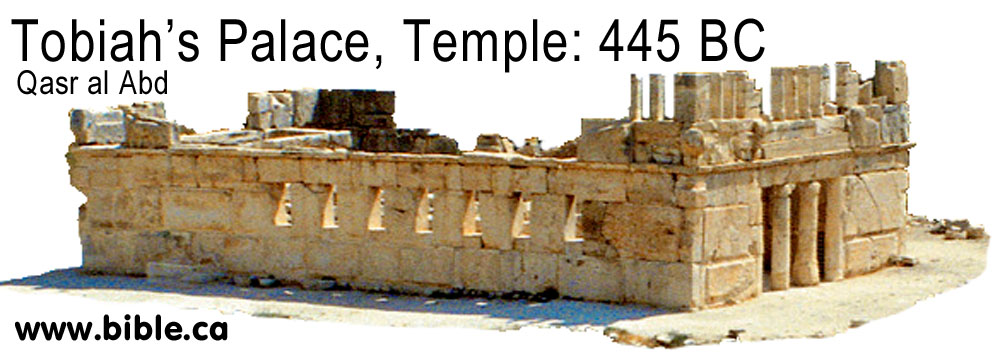
d.
The author standing at the front door of the palace of
Tobiah with his name etched in the stone:

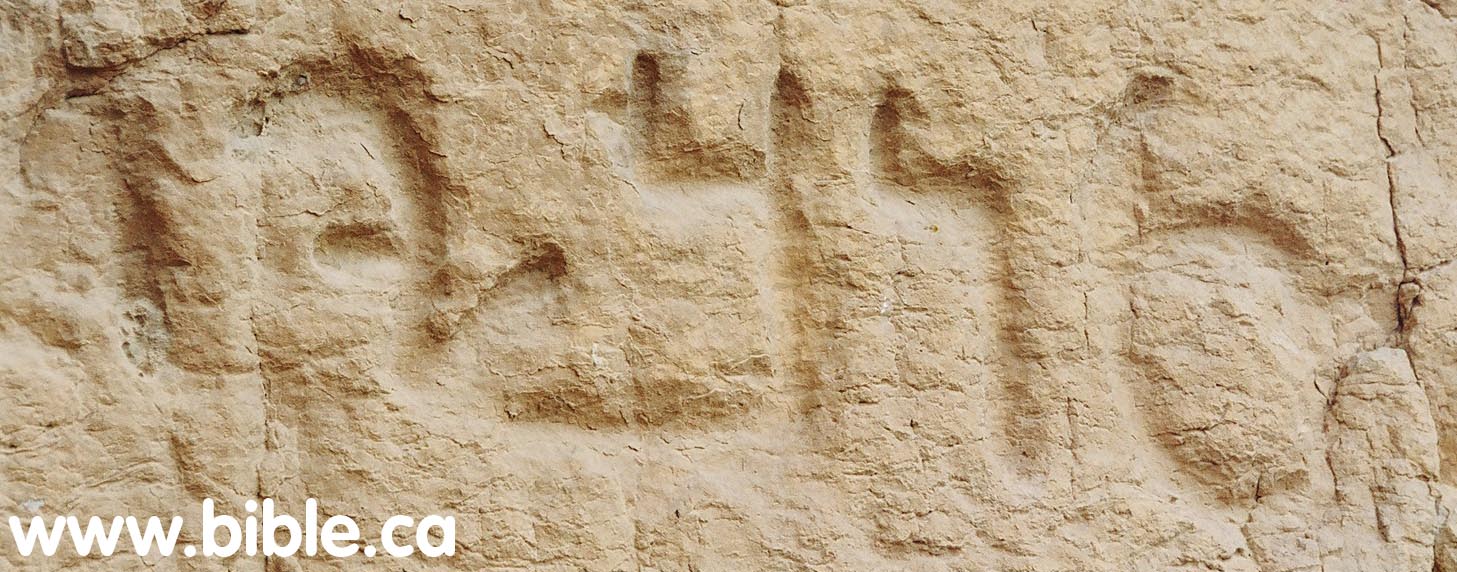
3.
408 BC: Sanballat, enemy
of the Jews, was governor of the Samaritans:
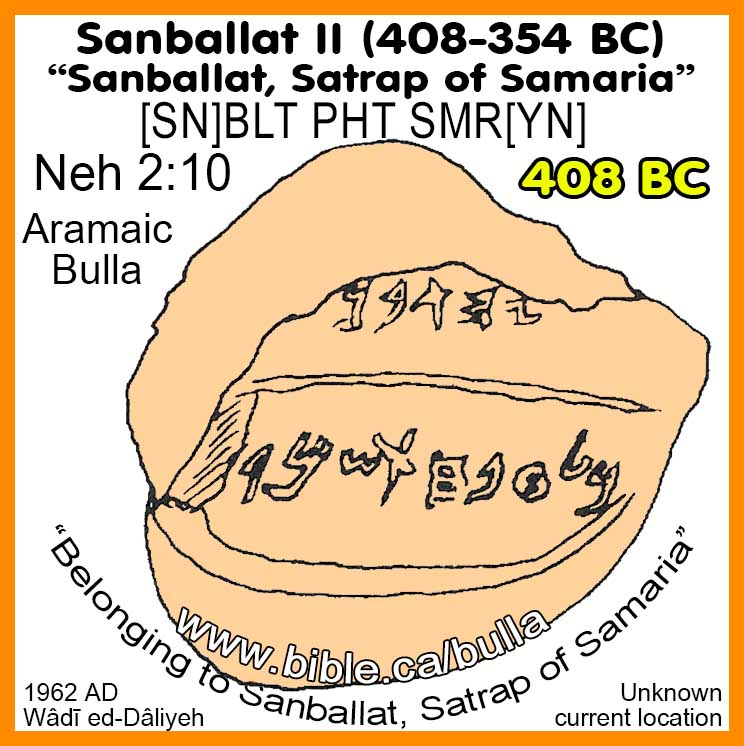
4.
407 BC: The Elephantine temple papyrus references Sanballat as the governor of Samaria.
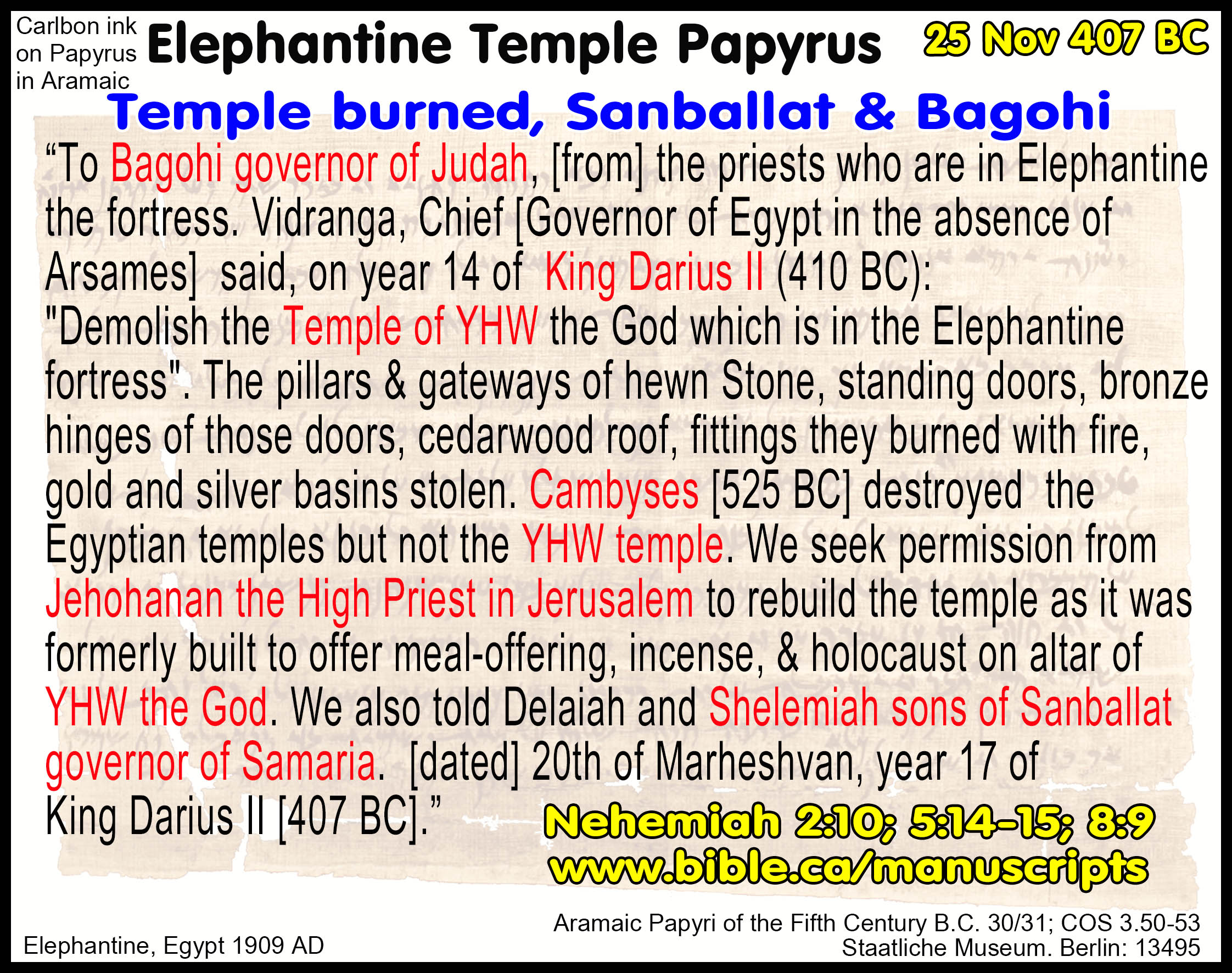
5.
250 BC: The synagogue at Delos made regular donations to the temple at Mt. Gerizim in 250 BC
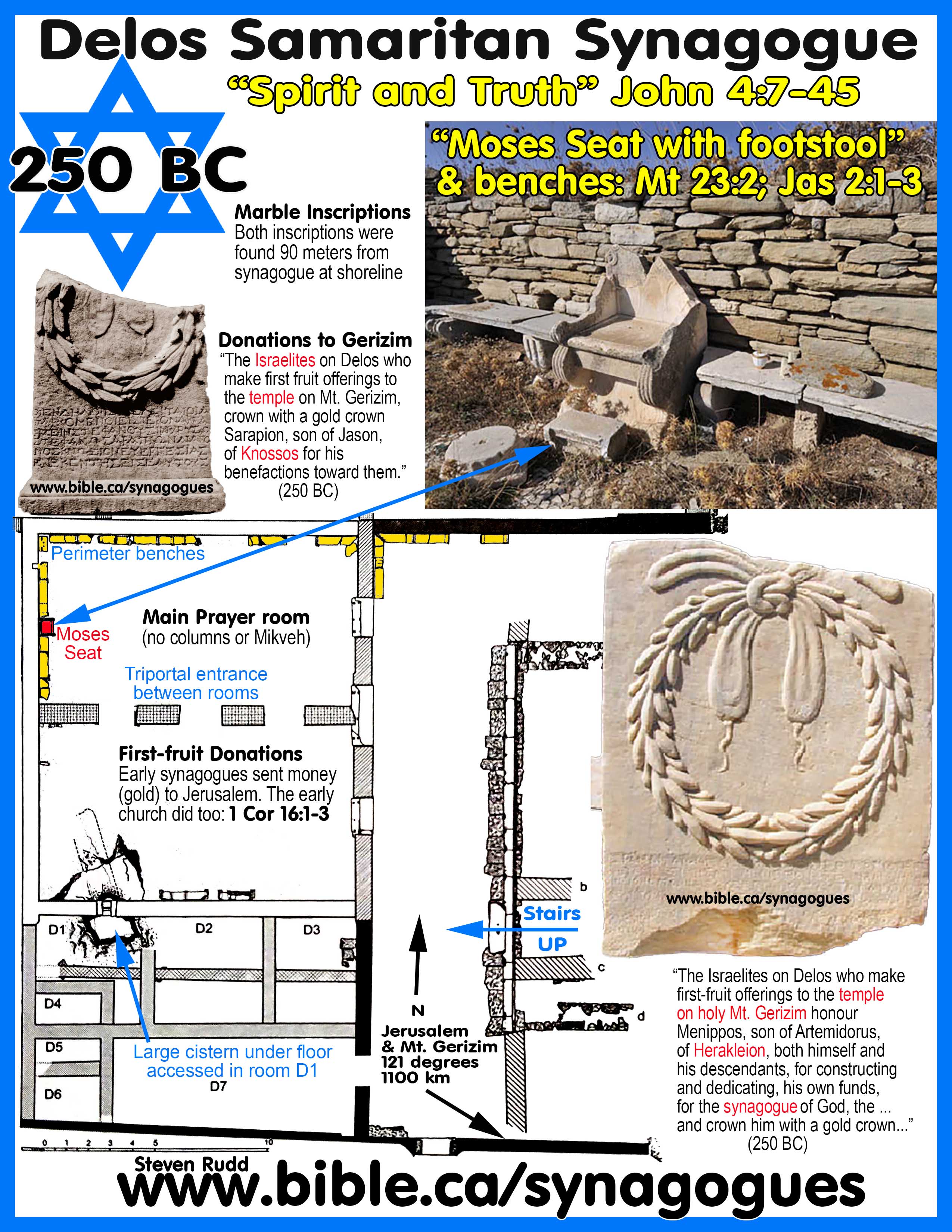
6. 542 AD: The Madaba Map has two locations for Mt. Gerizim and Ebal
a. See full outline on the Madaba Map
b. The Madaba map, is was clearly based upon the "Onomasticon" written by Eusebius in 325 AD, even though it differs at times from it.
c. The Duel over the Dual locations of Mt. Gerizim
d.
The Madaba map records the two locations: The true
location beside Shechem and the false Jewish location near Jericho.

Conclusion:
1. The Samaritans built their Samaritan Temple on Mt. Gerizim in association with the Mountain of blessings and changed the text to say the temple venerated the location of Joshua’s Altar!
2. The Bible is clear in that Mt. Gerizim is located beside Shechem, not Gilgal:
a. The oaks of Moreh were beside Mt. Gerizim and two Bible verses place the oaks of Moreh beside Shechem (modern Nabulus). (Genesis 12:6 and Genesis 35:4.)
b. Judges 9:7 likewise places Mount Gerizim directly beside Shechem: "Jotham went and stood on the top of Mount Gerizim, and lifted his voice and called out. Thus he said to them, "Listen to me, O men of Shechem, that God may listen to you." (Judges 9:7)
c. Even Eusebius in his Onomasticon was deceived by the fiction of the ancient Jews that the Samaritans had built their temple in the wrong location of Mt. Gerizim.
d. The Madaba Map of 542 BC was based upon Eusebius’ Onomasticon and perpetuated the Jewish fiction of two different locations for Mt. Gerizim/Ebal.
e. This means that Eusebius and the Madaba map and all modern Jewish fiction as parroted by the late Adam Zertal is wrong.
3. See also:
a. Ezra’s Anti-Samaritan Variants in the Quattuordecim (XIV)”
b. Ezra’s Variant: Change of tense from past “has chosen” to future “will chose”
c. Ezra’s Variant: Lev 26:31 change of singular “sanctuary” to plural “sanctuaries”
d. Ezra’s Variant: Deut 11:30 Deleted words “opposite Shechem”
In the final analysis, we can be certain that we possess the word of God!
This is what Jesus meant, when He said: "Scripture cannot be broken" (Jesus, John 10:35)
"My word will accomplish what I desire and succeed in the purpose for which I sent it." (Isa 55:11)
|
The Septuagint LXX “Scripture Cannot Be Broken” |
|||||
|
Start Here: Master Introduction and Index |
|||||
|
Six Bible Manuscripts |
|||||
|
1446 BC Sinai Text (ST) |
1050 BC Samuel’s Text (SNT) |
623 BC Samaritan (SP) |
458 BC Ezra’s Text (XIV) |
282 BC Septuagint (LXX) |
160 AD Masoretic (MT) |
|
Research Tools |
|||||
|
Steve Rudd, November 2017 AD: Contact the author for comments, input or corrections |
|||||
By Steve Rudd: November 2017: Contact the author for comments, input or corrections.
Go to: Main Bible Manuscripts Page
